Coastal real estate prices rise like the sea
Some counties see doubledigit percent increases
BY DORATHY MARTEL
Compared to the rest of the Northeast, housing in Maine looks like a bargain. According to the Maine Real Estate Information System, the median sales price for a Maine home in 2023 was $353,000. For the Northeast as a whole, the fourth quarter 2023 median was $698,000, as reported online by Federal Reserve Economic Data (FRED). Nationwide, the median was $417,000.
But a Maine home with water frontage or an ocean view is another story. Yes, you can find a twobedroom house in Beals listed at $169,000, but that’s a rarity on the Maine coast, where you can also buy a 10-bedroom property on Mount Desert Island for $17 million or an eight-bedroom home for $9,775,000.
Most of the coastal counties have seen a rise in median sales prices from 2022/23 to 2023/24.
The Maine Association of Realtors reported a yearto-year increase of 8.92% statewide; but except for Washington County (down 2.27%), the coastal counties saw significant increases—from a 10.67% rise in
PORT CLYDE RISING—
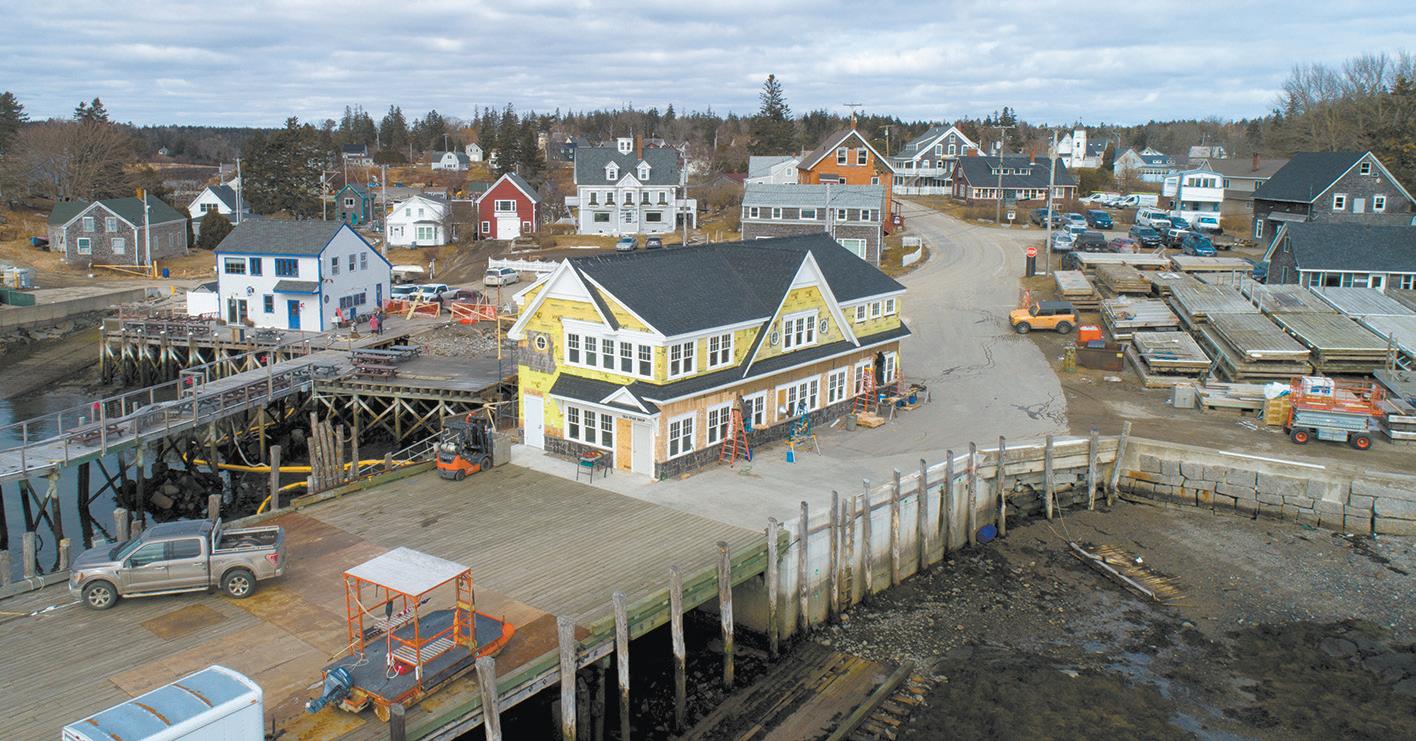
Knox County to a nearly 32% jump in Waldo County. Cumberland County, with the highest median price in the coastal counties ($525,000), saw a 16.6% increase.
Even with high selling prices, “There’s a shortage; inventory is low right now,” says Tacy Redlon, a broker with Better Homes & Gardens, The Masiello Group, who primarily covers Hancock County and eastern Penobscot Bay.
“That pandemic era could not sustain itself,” she notes, referring to a spurt of activity that occurred
when more people began working remotely and property changed hands in “a feeding frenzy.”
Monet Yarnell, a broker, auctioneer, and waterfront specialist at Sell 207 in Belfast and president of the Midcoast Board of Realtors, agrees that finding saleable properties is a challenge.
“Across the board we have a limited number of properties available,” she says.
continued on page 5
Seafood landing values up $25 million over 2022 Lobster sales to dealers up $72 million, but catch down
The state Department of Marine Resources announced on March 1 that 2023 was another strong year for Maine commercial fishermen who earned $611 million at the dock point of sales, an increase of more than $25 million over 2022.
“The Maine seafood industry continues to be a powerful economic engine for our state,” said Gov. Janet Mills in a press release. “The dedication to sustainability and premium quality by our fishermen, aquaculturists, and dealers is a source of tremendous pride
CAR-RT SORT POSTAL CUSTOMER
for everyone who calls Maine home.”
The jump in overall value is largely attributed to a strong boat price for lobster, Maine’s most valuable species in 2023. The price paid to fishermen increased from $3.97 per pound in 2022 to $4.95 per pound in 2023, netting harvesters an additional $72 million compared to the previous year, for a total value in 2023 of $464 million.
Almost 94 million pounds of lobster was landed in 2023, the lowest in 15 years. Industry advocates have suggested that the catch is a return to average after several years that saw landings of over 100 million pounds.
drop in that population which has triggered a change in the legal minimum and maximum sizes, which goes into effect in January 2025.
Maine oysters were the fourth most valuable harvested product at over $11 million on the strength of a 20-cent per pound increase in value.
“The price Maine lobstermen received last year is a reflection of the continued strong demand for this iconic seafood,” said DMR Commissioner Patrick Keliher. “Consumers and buyers recognize the Maine lobster industry’s longstanding commitment to sustainable, responsible harvesting practices and how it provides a unique, premium culinary experience.”
Maine’s elver fishery once again was the second most valuable in 2023, earning fishermen $19.5 million on the strength of a $2,009 per pound price.
Still, a three-year sampling of juvenile lobster showed an average 40% continued on page 5
NON-PROFIT ORG. U.S. POSTAGE PAID PORTLAND, ME 04101 PERMIT NO. 454 News
published by island institute n workingwaterfront . com published by island institute n workingwaterfront . com volume 38, no. 2 n april 2024 n free circulation: 50,000
from Maine’s Island and Coastal Communities
An aerial view of Port Clyde’s working waterfront shows construction is well underway after fire devastated three businesses in September. See more photos on pages 14-15. PHOTO: JACK SULLIVAN
Take our READER SURVEY Pages 19-20

Newfoundland, Maine share maritime past But Canadian
province’s story diverges from ours
BY PATRICIA ESTABROOK
PHOTOS BY RAY ESTABROOK
Ihad heard that when you went to Newfoundland you felt as though you were in Maine in the 1970s.
Since I remember that period vividly, I thought it might be fun to re-live my youth.But when I got off the ferry in Channel-Port aux Basques, I realized that I had not walked back in history, but I had walked into a dream. The fantastical mountains kneel in the crashing surf and every vista seems to be right out of a Tolkien novel. Newfoundland isn’t, and never was, Maine.
In 1497, the European explorer John Cabot visited Newfoundland on behalf of England. He was looking for gold and spices but what he found was even more important to the hungry people of Europe—cod. The Grand Banks were teeming with cod.
From the early 1500s on, French, English, Portuguese, and Basque fishers came to Newfoundland to change the fishing culture from subsistence fishing of the First People to a major export economy. For more than 400 years cod fishing was the mainstay of the Newfoundland economy.
Well into the 20th century fish flakes (drying racks) lined the waterfront streets of St. John’s, bringing the reek of drying fish and clouds of flies. St. John’s hosted fishing fleets from around the world and the province’s small “outport” towns sent their catches to St. John’s for export.
Cod was king but the fluctuations in price and catch size made
a precarious living for fishers. Gravel-filled glacial till soil and a short growing season discouraged commercial agriculture. Logging never assumed the importance it did in the Maine woods. The fishing industry controlled the economy of Newfoundland and it was a boom or bust existence for thousands of hardy men and women.
Newfoundland was a dominion of Great Britain until 1949 when it joined Canada as part of the province of Newfoundland and Labrador. In the 19th century Newfoundland considered becoming part of the U.S. and had it done so it might have become more like Maine, but its long history of allegiance to Great Britain shaped the thinking and economy of Newfoundland.
In the mid-20th century two events changed everything: the election of Joseph “Joey” Smallwood
as premier—serving from 1949 to 1972—and the collapse of the cod fisheries.
Smallwood was a visionary leader whose influence on the economy and culture of Newfoundland will be evident for a hundred years. He began the process that took a struggling colony to its present status as a stable Canadian province, but his long tenure as premier was not without challenges.
Smallwood was an innovator who backed numerous attempts to diversify the Newfoundland economy, most of which failed. Cod remained the monocrop of the Newfoundland economy. Then, in 1951, factory fishing changed the cod industry.
In 1968, at the height of the factory fishing period, 810,000 tons of cod were taken in factory fishing by international fishing fleets. By the 1990s the cod fishery had collapsed and a moratorium on cod fishing was established by the federal government in Ottawa. Newfoundlanders are famously proud of their homeland but the changes in the cod industry increased out-migration, particularly to the U.S. The cod processing stations, called fishing premises, that once dotted the coastline were abandoned. The cod drying flakes were removed. Even today the harbors of Eastern Newfoundland are mostly empty.

Fishing boats and pleasure boats are uncommon in the sparsely populated outport communities. This change is often tied to the statement reputed to have been made by Joey Smallwood, “Burn your boats,” when he was trying to
2 The Working Waterfront april 2024
Rough seas, rough-edged cliffs mark the coast.
A St. John’s streetscape shows the bright colors locals favor.

encourage the transition from smallscale fishing to a more consolidated (and he believed) a more profitable factory model. The boats are gone and so are many of the rural outports that were once an important part of Newfoundland’s heritage.
Changes as radical as those of the Smallwood era are unimaginable in Maine. In the period from the 1950s to the 1970s, Smallwood’s administration worked to bring Newfoundland up to the standards of Atlantic Canada and the U.S. One of the most significant attempts to create change was the closing of 200 communities and the resettlement of 28,000 people.
Today, many outports are merely summer colonies. Towns are consolidated. There is no sprawl. Newfoundlanders live within the confines of specific towns with vast empty spaces between settlements.
Almost all commerce is located in major towns and within those towns segregated into shopping districts. In rural towns you don’t step out to the corner store because usually there is no store or even a corner.
The outports are hollowed-out towns. Local schools, those that have not been consolidated, are serving fewer than a dozen children when there used to be hundreds. Parents commute to the major towns and local shopping is unavailable. Still, a love of place keeps residents clinging to the outports even in the face of dramatic changes.
Resettlement has been a challenge for Newfoundlanders but has brought benefits to visitors. In every community there are well maintained walking trails beside
the ocean where you can see icebergs floating by from June through August and the crashing surf all year long. Like Maine, most beaches are rocky and the Newfoundland waves from the North Atlantic are perilously cold.
Today’s Newfoundland seems prosperous in comparison to Maine. There are no mobile homes and every house, every shed, and even every doghouse is clad in vinyl siding. In Newfoundland vinyl siding has gone to heaven. Barns have been replaced by Quonset huts that were introduced during the World War II period and are remarkably common. A generous government and opportunities in the expanding alternative energy fields have brought prosperity
to the average Newfoundland family. Immigration from developing countries will shape the future of Newfoundland.
Downtown St. John’s combines past and present. On Water Street Celtic music from the Clancy Brothers and Irish Rovers billows out of the bars at all hours. Irish folk culture is more vibrant here than in Ireland. Kissing a cod fish in one of these bars allows you to become an honorary Newfoundlander. I skipped the cod but was embraced by a local family from an outport called Renews.
Music and storytelling venues dot the city of St. John’s even in the off season. Newfoundland Celtic music is nostalgic. It celebrates the love of place even more than romantic love. It is also
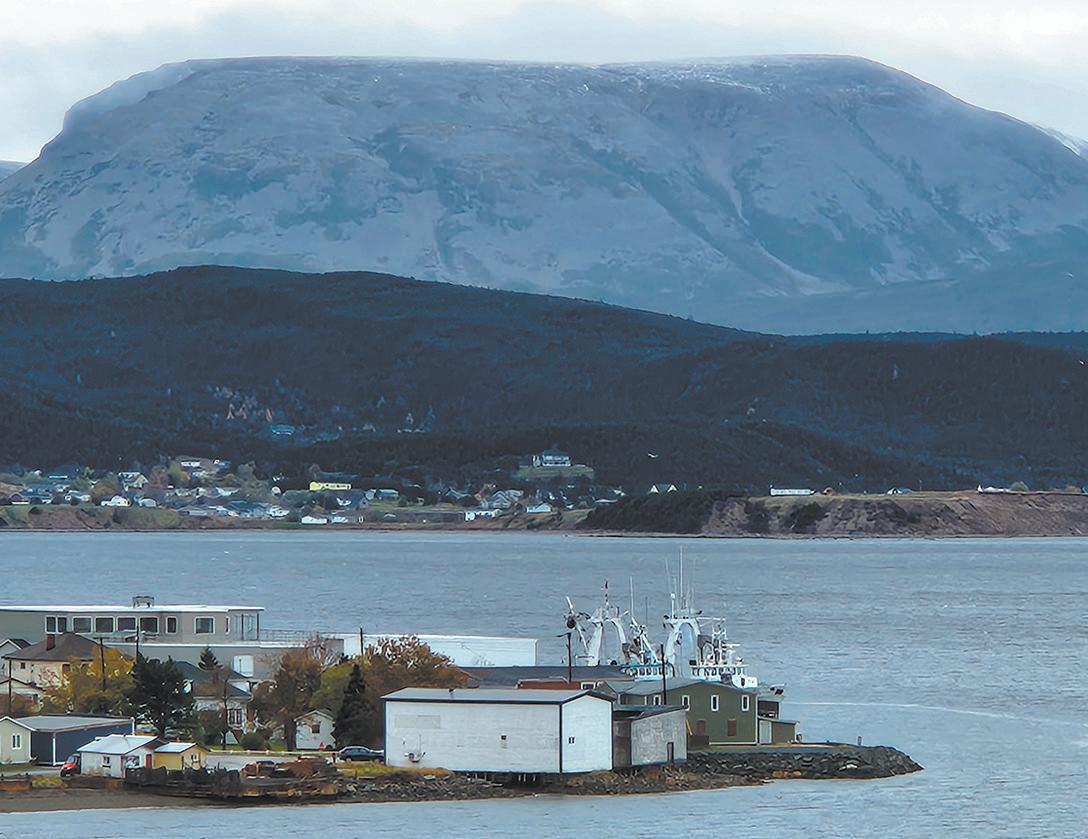
seductive and makes you fall in love with Newfoundland itself. Everyone in Newfoundland knows the Ron Hynes song, “Sonny’s Dream.” If you don’t learn the words the first time, don’t worry, you will hear it hundreds of times more.
The Rooms is a locus of art and culture for Newfoundland and Labrador. Part museum, part archives, part performance space, it is at the center and heart of St. John’s. The past never dies in Newfoundland and the exhibit at the Rooms about World War I brought me to tears. After two hours of viewing, I mourned for families I had never known.
Memorial University is just a short hop from downtown St. John’s and lends an international air to the city. New Canadians from across the world mingle with students whose heritage in Newfoundland and Labrador goes back for centuries. The new Canadians bring youth and vitality to St. John’s and the hope that they will choose to make Newfoundland their permanent home. The folklore department at Memorial University is considered one of the best in the world. Its influence has renewed interest in mummering, a Christmas tradition that was brought to Newfoundland from Ireland generations ago.
Maine and Newfoundland share a maritime past based on fisheries and the desire for new opportunities. Astute Mainers won’t look to Newfoundland as a nostalgic trip to the 1970s but will see the potential for a joint future of economic and social revitalization.
Patricia Estabrook lives in Belfast.
3 www.workingwaterfront.com april 2024
The Barrenlands in Chidley.
Gros Morne looms over Bonne Bay.
State selects Sears Island for wind port
Islesboro, Friends groups oppose decision
BY TOM GROENING
After years of deliberating on the best site to establish a port to service a planned offshore wind turbine array, Gov. Janet Mills announced Feb. 20 that the facility would be built on Sears Island in Searsport.
Port facilities in Portland and Eastport were under consideration, as was Mack Point on the mainland in Searsport. A hybrid plan that would have included both the existing piers at Mack Point and a new facility on Sears Island also was considered.
State officials asserted that a new “purpose-built port facility” on Sears Island would establish Maine’s place in the growing offshore wind industry and become a hub for job creation and economic development.
The land portion of the facility would allow for floating offshore wind fabrication, staging, assembly, maintenance, and deployment, which would have the turbines towed to their mooring sites. There is deep water access adjacent to Sears Island.
The array is proposed to include 10–12 turbines on semi-submersible floating concrete platforms, designed by the University of Maine’s Advanced Structures and Composite Center.
The site selection process was led by the Department of Transportation and Maine Port Authority, with the state concluding that the Sears Island parcel is “the most feasible port development site in terms of location, logistics, cost,
and environmental impact,” according to its announcement.
Advocacy groups, including the Friends of Sears Island and Islesboro Islands Trust, have expressed their opposition to the proposal, arguing that Mack Point would be a better choice. Mack Point, now owned and operated by Sprague Energy, has hosted port infrastructure for more than 200 years. It is about 500 yards from the site selected on Sears Island.
Environmental groups supporting the project include the Natural Resources Council of Maine, Maine Conservation Voters, and Maine Audubon. Labor groups have also endorsed the Sears Island choice.
Sears Island is a 941-acre state-owned island off the coast of Searsport, joined to the mainland by a causeway built in the late 1980s in anticipation of a container port being built there. Gov. Angus King reluctantly scrapped that proposal in 1996. The container port was one of a half-dozen industrial proposals, which included nuclear power plants, an aluminum smelter, coal gasification plant, and a liquefied natural gas port.
island, was placed in a permanent conservation easement held by the Maine Coast Heritage Trust, while the remaining one-third, or approximately 330 acres, was reserved by DOT for future development.
The site for the wind port is about 100 acres, which is about one-third of the transportation-reserved parcel, and a little more than one-tenth of the entire island. The estimated construction cost is $500 million, with funding likely to be sought from federal sources.
Last year, Mills signed legislation to advance offshore wind in Maine by aiming to develop up to 3,000 megawatts of offshore wind energy in federal waters.
“ The most feasible port development site in terms of location, logistics, cost, and environmental impact…”
After a lengthy stakeholder negotiation process, the island was divided in 2009 into two parcels: approximately 601 acres, or two-thirds of the
Feds make more work visas available
SENS. SUSAN COLLINS and Angus King announced that the Department of Homeland Security (DHS) and the Department of Labor (DOL) are expected to make an additional 64,716 H-2B temporary nonagricultural worker visas available for fiscal year 2024 on top of the congressionally mandated 66,000 H-2B visas that are available each fiscal year.
“These additional H-2B visas are a welcome relief for small businesses throughout Maine that continue to face a shortage of employees,” said Collins and King in a press release. “These visas are a lifeline for our state’s economy, helping businesses meet the increasing demand for their products and services.”
The supplemental allocation is expected to include 20,000 visas for workers from Colombia, Costa Rica, Ecuador, El Salvador, Guatemala, Haiti, and Honduras. In addition to the 20,000 country-specific allocation, 44,716 supplemental visas would be available to returning workers who received an H-2B visa, or were otherwise granted H-2B status, during one of the last three fiscal years.
Collins and King have consistently pushed DHS and DOL to increase the availability of H-2B visas, and they have worked to ensure that the H-2B visa program is efficient and effective. Last
year, they successfully urged the agencies to release the maximum number of H-2B visas, marking the first time the departments issued a single rule making available H-2B supplemental visas for several allocations throughout the entire fiscal year.
In June 2023, Collins and King sent a letter sent to DOL Acting Secretary Julie Su requesting an explanation for the extreme delays affecting the processing of labor certifications for H-2B visa applications.
The DHS appropriations bill passed by the Senate Appropriations Committee on July 27 includes report language drafted by Collins directing DHS, in consultation with DOL, to produce a report on “the economic impact of the H-2B visa program on a state-by-state and national level; the estimated number of H-2B visas that would have been required to meet demand in FY 2023 on a state-by-state and national level; and any adverse economic impact that resulted from the inability to meet such demand.”
As required by law, employers must first make a concerted effort to hire American workers to fill open positions. H-2B visas fill needs for American small businesses when there are not enough able and willing American workers to fill the temporary, seasonal positions.
disappointed in the governor’s breach of the state’s commitment” to prioritize Mack Point over Sears Island.
Islesboro Islands Trust said it would intervene “using every legal means available.” The group supports offshore wind “but affirms that the offshore wind manufacturing facility should be built at Mack Point,” according to a statement it issued after the site was selected.
Mack Point consolidates industry in one location, economizes on existing infrastructure, and replaces and remediates Mack Point’s brownfield history, the Islesboro group noted. It also said that construction costs at both sites were close to equal and that a rail line is available at Mack Point.
“This was not an easy decision, nor is it one that I made lightly,” Mills said of the site choice.
“For more than two years, my administration has evaluated Sears Island and Mack Point thoroughly and with an open mind, recognizing that each site has its own set of benefits and its own set of drawbacks.”
The governor acknowledged that the island, which has recreational trails developed by the Friends group, “is enjoyed by many people.”
Former Islesboro Select Board chair Arch Gillies said he was “profoundly
Dan Burgess, director of the Governor’s Energy Office, said a port “is a critical step … supporting the generation of clean, affordable, reliable energy for Maine and the region.”
Matthew Burns, executive director of the Maine Port Authority, said “Our heritage as a seafaring state makes perfect sense for utilizing one of Maine’s best assets, its deep-water ports.”
David Gelinas, president of the Penobscot Bay & River Pilots Association, noted that Sears Island “will minimize impacts from southerly winds and seas, while providing safe shelter for smaller vessels that will be necessary to service the port,” and offers the most direct approach in and out of the Searsport navigation channel and allows the existing docks at Mack Point to continue accommodating vessels.

NEW ON THE PATROL—
4 The Working Waterfront april 2024
The newest Maine Marine Patrol officer Amos Abbott, shown here with Col. Matthew Talbot (left) and Department of Marine Resources Commissioner Patrick Keliher (right), will serve in the FriendshipWaldoboro-Cushing patrol region.
Mills seeks disaster declaration
Gov. Janet Mills has formally requested that President Joe Biden issue a major disaster declaration to help Maine’s eight coastal counties recover from the back-to-back severe storms on Jan. 10 and Jan. 13 which brought significant flooding and damage.
In a letter to Biden, Mills noted the cost of damage from the two weather events—estimated at $70.3 million for public infrastructure damage alone—is beyond the ability of the state to address.
If the president approves the governor’s request, Maine would gain access to federal funds it could use to repair damaged roads, bridges, public buildings, utilities, and other public infrastructure in Washington, Hancock, Waldo, Knox, Lincoln, Sagadahoc, Cumberland, and York counties.
In addition to requesting public assistance, the governor asked Biden to authorize individual assistance to eligible families impacted by property damage in Washington, Hancock, Waldo, Knox, Lincoln, Sagadahoc, Cumberland, and York counties.
“Given that affected homeowners are also having to recover from demolition of the waterfront infrastructure that inherently supports their livelihood, the Individual Assistance program is just one
REAL ESTATE continued from page 1
Also, what buyers want tends to be very specific, and, says Yarnell, “Homes are so unique... It’s like a fruit basket.”
Proximity to amenities and airports are among the factors buyers consider. Elizabeth Banwell, senior vice president and broker at Legacy Properties Sotheby’s International Realty in Portland, notes: “A lot of times people have in their minds that they want to be a certain distance from Portland or Boston.” Yet she also sees activity in places such as St. George, which has had “a little boomlet,” and Eastport, where a house listed for $375,000 received an offer of $699,000.
Redlon sees buyers looking farther Downeast than they intended, seeking more affordable properties than they can find in Camden or Belfast.
The buyers are a mix of in- and out-of-staters. Redlon says many of her buyers are “early retirees”
SEAFOOD VALUE
continued from page 1
“Maine’s elver quota of 9,688 pounds expires after this year,” Keliher said. “Fortunately, because of the strong management measures we’ve instituted here in Maine, the Atlantic States Marine Fisheries Commission American Eel Board has decided that the existing quota will remain in place, preventing what could have been a loss of millions of dollars in income for Maine’s elver industry.”
Through an addendum to the fishery management plan for elvers, ASMFC will establish the number of years the current quota will remain in effect.
Softshell clam diggers earned $13.8 million in 2023, which made the fishery the state’s third most valuable.
“DMR’s Nearshore Marine Resources Program, launched in 2022, has been working hard to support this vital fishery through outreach, funding, and collaboration with towns to develop effective shellfish management strategies,” said Keliher.
More information about the program and funding opportunities can be found on DMR’s website.
necessary component to the comprehensive recovery needs of disaster survivors spanning all eight coastal counties,” wrote Mills in her request. “With much of the marine and aquaculture field operating out of primary homes with private docks, hundreds of disaster survivors are now fighting to sustain generational family businesses with limited support.”
Maine produces 90% of the nation’s lobster, she noted, “and is home to a thriving marine economy now at risk of decline. The recovery of Maine’s coastline will require the support of every federal resource available, and due to the compounded affects sustained by the coastal primary homeowners that help to sustain Maine’s economy, recovery is uncertain without the Individual Assistance program.”
The governor has also separately proposed $50 million to help communities rebuild infrastructure and enhance climate resiliency by introducing it as standalone legislation rather than as part of the forthcoming supplemental budget. It’s complemented by $5 million in her supplemental budget to help another 100 cities, towns, and tribal governments create local plans to address vulnerabilities to extreme weather through the Community Resilience Partnership.
who have “some energy and some ideas,” and that the more expensive properties are generally going to incomers. Yarnell’s clientele skews younger and is a split of people from Maine and from other states. Banwell, too, sees both buyers from out of state and those who were already living in Maine.
Fears about climate change don’t seem to be dissuading buyers, despite widespread reporting on flooding in Maine in late December and early January and concern about the ability to insure property. All three brokers interviewed said they are frank with potential buyers about the reality of living near the water.
“I do think that people will be more aware,” says Redlon. “They’re going to get some wind and they’re going to get some tide rises.”
Yarnell adds that, “Someone might choose to be a little higher as long as they have access to the beach.” People who are attracted to the coast because they have boats tend to do their research, she says.
Maine oysters were the fourth most valuable harvested product at over $11 million on the strength of a 20-cent per pound increase in value.
Menhaden, used as bait for the lobster fishery, was the state’s fifth most lucrative fishery in 2023, with a landed value of more than $10 million.
Maine’s groundfish industry also saw an increase in landings and a more stable price due in part to investments DMR made in the Portland Fish Exchange, Vessel Services, and the Maine Coast Fishermen’s Association with COVID relief funds from NOAA.
“DMR is proud to have supported fuel, ice, and landing fee rebate programs at the Portland Fish Exchange and Vessel Services,” said Keliher. “These programs, which helped to reduce costs, along with market stability enabled by MCFA’s Fishermen Feeding Mainers program, were critical to maintaining and increasing landings of groundfish in Maine. It’s important work and a positive story; fishermen were able to keep working, critical infrastructure has been maintained, and fresh, healthy Maine seafood went to schools and families in need.”








5 www.workingwaterfront.com april 2024 156 SOUTH MAIN STREET ROCKLAND, MAINE 04841 TELEPHONE: 207-596-7476 FAX: 207-594-7244 www.primroseframing.com G eneral & M arine C ontraC tor D re DG in G & D o C ks 67 Front s treet, ro C klan D, M aine 04841 www. pro C k M arine C o M pany. C o M tel: (207) 594-9565 National Bank A Division of The First Bancorp • 800.564.3195 • TheFirst.com Member FDIC • Equal Housing Lender DREAM FIRST Advertise in The Working Waterfront, which circulates 45,000 copies from Kittery to Eastport ten times a year. Contact Dave Jackson: djackson@islandinstitute.org 43 N. Main St., Stonington (207) 367 6555 owlfurniture.com A patented and affordable solution for ergonomic comfort Made in Maine from recycled plastic and wood composite Available for direct, wholesale and volume sales The ErgoPro 43 N. Main St., Stonington (207) 367 6555 owlfurniture.com A patented and affordable solution for ergonomic comfort Made in Maine from recycled plastic and wood composite Available for direct, wholesale and volume sales The ErgoPro
Reliable transportation for all of your island needs 207-466-2636 www.midcoastbargeworks.com
from the sea up
The storm damage we cannot see
Community response must include compassion
BY KIM HAMILTON
ALMOST TWO MONTHS after the January storms pummeled the Maine coast, we are still piecing together a full picture of the destruction.
In the direct aftermath, of course, communities could document buildings now angled slightly off their foundations or entirely set adrift, pilings separated from their pins, and beaches and coastal frontage now missing yards of sand and soil.
We know hundreds of commercial boats are at risk of a curtailed fishing season because they can no longer land their catch on their usual piers and wharves. Delays are costly. They mean fresh catch won’t make it to market, not only depriving consumers of exceptional Maine seafood but also reducing the livelihoods of harvesters and their families.
The observable and documented damage to our coastal infrastructure was so widespread and costly that Gov. Mills requested that President Biden issue a Major Disaster Declaration. Approval of that request unlocks essential federal funds to repair an estimated $70.3 million in damages to public infrastructure.
Many of Maine’s fishermen and aquaculturalists, however, operate out
of their homes and from private docks. Because of the exceptional impact to these private facilities, the governor’s request also included special consideration for individual households through the federal Individual Assistance Program. The request is in addition to new proposed state funding to strengthen community climate resilience and infrastructure.
While some may chafe at the timeline, the bureaucracy, the politics, and the paperwork, these funds will be a lifeline for this state and our coastal and island economies.
Anyone in the disaster preparedness and recovery fields knows, however, that the cost of a disaster is more than material. There are profound, important, and long-term mental health costs that often go unseen or unrecognized. Studies after hurricanes Sandy and Katrina have shown an increase in PTSD in the immediate aftermath and the persistence of depression long after a damaging storm. A growing body of research on the changing climate and recurrent, severe storms also points directly to the public and mental health costs.
While getting back to a new normal is important, people differ in their ability to reset and adjust. Repeated extreme events are especially challenging for older people, people with
rock bound
Maine—our next big moves
Time to confront harsh realities
BY TOM GROENING
I HAVE A SHARP memory of Angus King’s inauguration as governor in January of 1995. I was editor of the Republican Journal weekly newspaper in Belfast then, and we had endorsed him for the office.
As an independent candidate, I found his thinking on the issues of the day refreshing, and since he was bound to neither major party, he could be candid about where he stood, instead of parroting party lines.
Our kids were ten and seven at the time, old enough to understand some of the governor’s speech and I had them watch it. King included a specially made film by Bar Harbor’s Jeff Dobbs, he of High On Maine fame, featuring footage shot by helicopter (today it would be a drone) of the coast and inland parts of our state, with narration extolling Maine’s rich and proud history.
It was a master stroke by King, coming as it did as Maine was crawling out of the recession of 1991, which was especially severe in the Northeast.
I’ve long felt our state has an inferiority complex, probably formed by
what was essentially an economic slump from 1930 to 1980. We were poor. Many jobs relied on hard, seasonal resource extraction—fishing, logging—textile and shoe manufacturing, and processing agricultural products like chicken and potatoes.
Along comes King in 1994 with his “Maine is on the Move” gubernatorial campaign, and suddenly we begin to believe it and start noticing and reporting back how fast the ship of state is cruising.
I was reminded of this during Gov. Janet Mills’ State of the State address in late January. She took the unusual step of providing many of her policy proposals to the legislature in writing, while focusing her in-person remarks on what might be described as a moral call to the state.
Specifically, she highlighted two hits the state has taken in recent months— destructive storms and mass shootings. Both demand our action.
The shootings—18 massacred in Lewiston in October and four in Bowdoinham in April—demand a rethinking of our policy on guns, despite being a state with a long tradition of responsible use.
disabilities, people with a history of trauma, and first responders.
It’s not difficult to understand why. The flooding of the causeway between Deer Isle and Stonington, for example, made access to emergency care especially precarious. Flooded communities all along the coast faced the same kind of heightened uncertainty.
The disappearance of the historic South Portland fish shacks produced yet a different kind of loss. They simply slipped into the ocean, erasing family histories and cultural touchstones overnight. There isn’t a price tag for that kind of grief.
Fortunately, we have tools to address these hardest-to-quantify damages, the psychological ones. Healing begins with community support. In this sense, Maine coastal and island communities have a lot to teach the world. Our coastal and island communities are models of connectedness, and staying connected is a salve for mental anguish.
The January storms are good reminders to exercise our community muscles, to check in on our neighbors, and to frequent local businesses, even weeks after the initial damage. Our colleagues at Maine Seacoast Mission and the Maine Coast Fisherman’s Association have resources that can help, too.

A solutions mindset can also have healing powers. This is why efforts like the state’s Community Resilience Partnership are so important. As one of the service providers, Island Institute, along with many others, is fostering community-wide conversations in island communities to help build resilience in the face of climate change. There are models of community resilience taking root in towns across the state from which we can learn and draw strength.
Maine coastal communities will emerge from the January storms stronger, more informed about the pernicious impact of sea level rise, flooding, and extreme weather, and they will resolve to act. I hope we’ll all emerge stronger, too, in our appreciation for the curative powers inherent in closely-knit communities and the ongoing need to attend to the storm damage that we cannot see.
Kim Hamilton is president of Island Institute, publisher of The Working Waterfront. She may be contacted at khamilton@islandinstitute.org.
Mills persuasively argued that some commonsense steps—strengthening the law that allows a judge to order the seizure of weapons and closing the loophole that allows people banned from owning guns to purchase them privately—would go a long way toward making Maine safer.
And being seen as a “safe” state is critical to our economic future. Tourism surveys show this status is a big part of our allure. Citing King again, who often says that Maine is a big, small town, the safe vibe also is key to how we function, from our local government and community institutions to our neighborly concern and charitable generosity.
The storms Maine got walloped by— heavy rains in December that wiped out roads and bridges inland, and two big wind and rain events in January that coincided with high tides which devastated working waterfronts and more—must be understood as related to a warming climate.
Yes, we’ve seen devastating storms before; remember the 1978 blizzard? But 2023 was the warmest year ever recorded globally. And the years trailing it on the top ten list are all from

this century. Warmer air holds more moisture, increases wind speeds, and expands the ocean. So, of course our storms will be worse.
Addressing our carbon pollution is overdue, but perhaps now it will no longer be seen as a hyperbolic warning. It’s happened, and its impacts will cost us millions. If we want to conserve what we have, both natural and built, and hang onto more of our money, we must act.
Mills’ creation of the Maine Climate Council sure looks wise at this point. Setting goals, on both climate and guns, is an important first step, but now we need state government—including those on both sides of the aisle—to implement changes. They won’t all be painless. But they surely will help us avoid the all-too-fresh pain of mass shootings and catastrophic storms.
Tom Groening is editor of The Working Waterfront. He may be contacted at tgroening@islandinstitute.org.
6 The Working Waterfront april 2024
INFLATION BUSTER—
Even in 1900, people made the short trek across the harbor from Portland to Peaks Island to enjoy that offshore experience. Information on the Library of Congress website notes this is the Forest City Landing in 1900. The sign on the building reads “The Peaks Island Ferry Reduced and Keeps the Fare at 5 (cents) between Portland and Peaks Island the Year Around.”

Offshore wind threatens centuries of fishing Proposal creates more problems than it solves
BY GLEN LIBBY
THE NEW ENGLAND electric grid— ISO New England—has a website that includes a display featuring two pie charts that show where our electricity is coming from, updated in real time.
Right now, “renewables” are at 7% of our total energy mix.
Wind is 28% of that 7%, solar is 10% of that 7%, and the rest of the renewables come from burning wood, trash, and methane from dumps.
Hydro isn’t listed as renewable, natural gas and nuclear usually make up the lion’s share, with hydro averaging around 9%.
Then there are imports, which vary during the time of day and what the weather is like—wind and solar are very weather- and time-of-day- dependent.
Many people today think that offshore wind power will be able to give us abundant (long-lived?) clean energy.
The water in the Gulf of Maine is very deep, any turbines sited there will be on floating platforms anchored to the seabed with giant chains. It is important to remember that the Gulf of Maine is the life blood of all our coastal fishing communities.
I participated in an interesting project some years ago when the Maine Coast
Island Institute Board of Trustees
Kristin Howard, Chair
Douglas Henderson, Vice Chair
Kate Vogt, Treasurer, Finance Chair
Carol White, Programs Chair
Bryan Lewis, Philanthropy Chair
Shey Conover Secretary, Governance Chair
Megan McGinnis Dayton, Ad Hoc Marketing & Communications Chair
Michael P. Boyd, Clerk
Sebastian Belle
David Cousens
Michael Felton
Nathan Johnson
Emily Lane
Michael Sant
Michael Steinharter
Donna Wiegle
Tom Glenn (honorary)
Joe Higdon (honorary)
Bobbie Sweet (honorary)
John Bird (honorary)
Kimberly A. Hamilton, PhD (ex officio)
Fishermen’s Association was formed. We worked with Island Institute to document how each fishing community extended far out to sea. Each community has traditional grounds that have been worked for centuries by fishermen from those communities. Fishing sustains coastal New England.
If offshore wind industrialization is allowed in these fishing grounds the communities connected to these areas will suffer. Are you willing to take a map of the state of Maine and eliminate the fishing grounds for these fishermen?
concrete, carbon fiber, and whatever else goes into the industrial power stations off the edge of the continental shelf after they break down.
Offshore substations that convert AC power to DC power will be continuously pumping 90-degree water into the ocean when the turbines are spinning.
If offshore wind industrialization is allowed in these fishing grounds the communities connected to these
Just going somewhere else seems reasonable to some, usually people with no fishing experience, but it is much more complicated than that.
areas will suffer.
Pieces of the equipment like turbine blades will break off, the bottom will be jet-plowed to lay cables, and you will not be able to set your fishing gear in these areas ever again, or until the next glacial period pushes the steel,
And yet the premise for offshore wind is that it is clean energy, good for the environment, and it will help control the climate, so we don’t die from global warming.
Now go back to the ISO New England data and ask yourself: “How many offshore wind turbines will it take to raise the percentage of power for the New England grid to have a meaningful impact on emissions?”
Data gets presented about how many megawatts of power each turbine produces, so-called nameplate power. That number assumes that they function at 100% capacity all the time. Nameplate is used to predict how many homes will be powered by turbines. The truth is that they only produce on
THE WORKING WATERFRONT
Published by Island Institute, a non-profit organization that works to sustain Maine's island and coastal communities, and exchanges ideas and experiences to further the sustainability of communities here and elsewhere.
All members of Island Institute and residents of Maine island communities receive monthly mail delivery of The Working Waterfront.
For home delivery: Join Island Institute by calling our office at (207)
average just below 40% of the time, so any data about homes must take this into consideration.
The Gulf of Maine is a unique ecosystem, almost an inland sea, and incredibly productive. It is this productivity that sustains our coastal fishing communities. This productivity is driven by currents that originate in the Bay of Fundy and circulate throughout the Gulf of Maine unobstructed.
These currents have evolved over centuries, since the ice sheets retreated, and marine species depend on an unobstructed flow to live and reproduce as they have for centuries. Industrialization of our fishing grounds puts this at risk.
Maine should wait to develop other sources of power that won’t harm our fisheries and are robust enough to eliminate a substantial portion of our carbon emissions.
Offshore wind power is the wrong choice.
Glen Libby is a 45-year veteran of the commercial fishing industry and now runs Port Clyde Fresh Catch. He lives in Port Clyde.
Editor: Tom Groening tgroening@islandinstitute.org
Our advertisers reach 50,000+ readers who care about the coast of Maine. Free distribution from Kittery to Lubec and mailed directly to islanders and members of Island Institute, and distributed monthly to Portland Press Herald and Bangor Daily News subscribers.
To Advertise Contact:
Dave Jackson djackson@islandinstitute.org
(207) 542-5801
www.WorkingWaterfront.com
7 www.workingwaterfront.com april 2024 op-ed
594-9209 E-mail us: membership@islandinstitute.org • Visit us online: giving.islandinstitute.org 386 Main Street / P.O. Box 648 • Rockland, ME 04841 The Working Waterfront is printed on recycled paper by Masthead Media. Customer Service: (207) 594-9209
Maine’s lighthouses face troubling recovery
Damage from storms not easily repaired
BY SARAH CRAIGHEAD DEDMON
Back-to-back storms slammed into the coast of Maine on Jan. 10 and Jan. 13, breaking state records for the highest tides since 1978 and delivering extensive damage along the entire coastline. Though final tallies are not in, statewide damages to public infrastructure—things like piers, roads, and bridges—are estimated at more than $70 million.
The storms also delivered extraordinary damage to more than a third of Maine’s lighthouses.
“What really hurt us was that the storms were so close together,” says Bob Trapani, executive director of the American Lighthouse Foundation (ALF). “Whatever the 10th compromised, the 13th just took it out. These old foundations didn’t stand a chance in the back-to-back battery.”
Many of the damaged lighthouses are structures that have already seen their fair share of violent weather.
“The Hurricane of 1938 wiped out Rhode Island’s Whale Rock Light and the keeper was never found. It did a lot of damage to other lighthouses, too, and killed seven lighthouse service members,” says Jeremy D’Entremont, historian for the U.S. Lighthouse Society and host of the society’s longrunning podcast, Light Hearted.
“There have been a few other storms in history that did a lot of damage to lighthouse properties,” says D’Entremont. “But other than the 1938 hurricane, they don’t compare to these storms.”
Costs to repair Maine lighthouses might be measured in the millions. At least 24 of Maine’s 67 lighthouses were damaged in the January storms, according to a survey conducted by ALF, and more damage reports are expected this spring, for offshore lights still difficult to reach in winter waters.
“Routine maintenance on a lighthouse is something you can schedule, you can budget for it. Offshore, that might be $20,000 every five years,” says Ford Reiche, who restored and owns Halfway Rock Light in Casco Bay. “But then you throw a storm at it and it’s $250,000, and that can’t be phased. That’s the thing that’s going to throw a lot of chaos at these lighthouse owners.”

trip to survey 23 Maine lighthouses, including Mt. Desert Rock Light and Matinicus Rock Light, both more than 25 miles offshore.
“It pulls at your heart to see the damage,” says Trapani. “I don’t think people understand. The sea does unimaginable things at these places.”
How—and in some cases, if—the most damaged lighthouse properties will be restored is an open, and urgent, question, says Trapani.
“What’s sad is, if we’re not able to strengthen these lighthouses today it only becomes more expensive tomorrow, and will we even have all of them?” asks Trapani. “Time is not on our side with these lighthouses.”
In February, Gov. Janet Mills requested a Major Disaster Declaration from President Biden. If approved, it could make available some Federal Emergency Management Agency grants for qualifying nonprofits.
At least 24 of Maine’s 67 lighthouses were damaged in the January storms.
On the high end, some Maine lighthouses might need $2 million in storm repairs, says Reiche.
“Some of the biggest costs will be the access points. Ram Island in Boothbay lost the walkway from the island to the lighthouse,” Trapani says. “As of right now, the Coast Guard can’t even access that light. Whitehead Island was another one where the boathouse collapsed and was pretty much destroyed. They lost their entire walkway to the pier.”
After the storms, Trapani and Reiche embarked on a 243-mile helicopter
Access to FEMA grants to pay for lighthouse storm repairs will depend in part on who owns the damaged lighthouses, whether they’re public or private property. Of Maine’s 67 lighthouses, part or all of 33 lighthouse properties are owned and operated by a branch of government—some state, some federal, and some municipal, with clear sources of funding. In some cases, nonprofits care for all or part of the property while the government runs the lighthouse works. Sixteen are owned by private individuals, and 18 are mostly the responsibility of nonprofits.
The American Lighthouse Foundation is ramping up to assist in the competitive and complex FEMA grant application process. Federal grants might also be made available
for prevention measures, or disaster mitigation, too, to prevent more damage in the future.
“We need some professional folks who can help us navigate hazard mitigation as well as disaster relief,” says Reiche. “What I’m going to do at Halfway Rock is secure the dock and the ramp and the boathouse more securely to ledge. If measures like those had been taken before the January storms, the statewide lighthouse damage would have been much less.”
Many of the hazards that damage lighthouses, like high winds and flooding, aren’t covered by insurance policies. And even in a year without punishing storms, access to historic preservation funding is nearly nonexistent.
“The grants are very, very hard to come by. I have never gotten grants for Halfway Rock,” says Reiche. Halfway Rock’s light is currently not functioning because, during the storms, water crashed through the building housing the light’s electronics.
“Most of the lighthouses in Maine are in the hands of local organizations that just have no resources. It’s astonishing because these lighthouses are built to last, but now we’re up against a new level of intensity and there are no established pipelines of money,” Reiche says.
working on something,” says Mohney. “The challenge and the responsibility that these stewards have taken on is to their great credit. Because for Maine, these are symbols of the state, and these organizations that have assumed ownership have taken on the responsibility to preserve those for everyone.”
There’s one way any Mainer can help lighthouses, says Trapani, and that’s by choosing the Maine Lighthouse License Plate. In 2021, Maine lighthouse supporters came together and founded the Maine Lighthouse Trust, which then purchased the license plates now sold by the state. Ten dollars of every plate goes directly to the Trust.
“This organization is going to take that money and grant it out to those organizations most in need,” says Trapani.
“ Time is not on our side with these lighthouses.”
—Bob Trapani
Though Maine isn’t home to the most lighthouses—that distinction belongs to Michigan with 129—it is home to some of the most iconic lighthouses, like Pemaquid Point Light, which is featured on the Maine state quarter. It lost part of its 19th-century bellhouse in the storms.
There isn’t a lot of historic preservation money in the state’s grant program, says Kirk Mohney, Maine’s state historic preservation officer. The agency provides technical assistance to anyone undertaking historic projects and currently holds preservation covenants on the 25 lighthouses that were transferred to nonprofits through the Maine Lights program.
“We’re in a fairly regular conversation with the groups that may be
“Maine lighthouses are some of America’s oldest as a group and they have a great place in the history of our nation,” says Trapani, who has penned six books about lighthouses, including his most recent release, Beacons of Wonderment: A Fascination with Maine’s Lighthouses.
“Maine lighthouses are especially beautiful,” Reiche says, “and there’s also something unique about the nature of the Maine coast. Our lighthouses aren’t on long, flat beaches like many states are. Maine lighthouses are on heights of land, and some are way offshore, in the most grisly locations. These are badass lighthouses, for sure.”
8 The Working Waterfront april 2024
The January storms flooded the foundation of Islesboro’s Grindle Point Lighthouse.
Down the drain, and then what?
Casco Bay’s runoff problems exacerbated by storms
BY STEPHEN RAPPAPORT
After the weather Maine experienced in December and January, even the staunchest climate change skeptic had to admit that something is up.
Three powerful storms—a rainstorm in December and two coastal windstorms in January—roared through the state.
Several factors, other than their arrival in rapid succession, made those winter storms unusual. They brought lots of rain, especially in December, but very little snow. The two January storms brought the highest tides seen along much of the Maine coast since at least the blizzard of 1978.
They wrought uncountable hardship and, in aggregate, millions of dollars in damage to public and private infrastructure primarily as a result of flooding, both inland and in Maine’s many harbors.
The washed-out roads and bridges around the state were obvious—guests and workers at the Sunday River were reportedly trapped at the ski resort for more than two days before the road was reopened—and photos of flooded businesses, destroyed wharfs, and other damaged coastal infrastructure made national news.
But there was another consequence of the storms that received, perhaps, less immediate attention: the impact
of runoff from the torrential rain and receding tide—stormwater—on the state’s coastal ecosystems.
That was the topic of an online “Coffee with the Casco Baykeeper,” Ivy Frignoca, hosted via Zoom by the Friends of Casco Bay in early February. Stormwater runoff and pollution have been long-term concerns of the organization and its Baykeeper, and the network of citizen “water reporters” have been monitoring their effects on the Casco Bay watershed for years. Those effects, positive and negative, are both significant and growing.
Frignoca explained that stormwater is “any form of moisture that falls from the sky” in quantities significant enough to “run off from the land into our waterways.” Stormwater can become polluted both by what’s in the atmosphere—dust, chemicals—and by what it comes into contact with on the ground.
“And that could be, say, cow manure or fertilizers from farm fields. It could be fertilizers and pesticides from lawns. And it is increasingly any kind of pollution that is on our urbanized landscapes, like heavy metals, car exhaust, cigarette butts, pet waste, anything on our built surfaces that collects there and then runs off in the water.”
In winter, additional pollutants come from the salt used to keep roadways, steps and sidewalks free of ice, which ultimately washes into streams and
Bridge work planned in Acadia
IN PARTNERSHIP with the National Park Service, the Federal Highways Administration will begin the rehabilitation of Jordan Pond Road bridge in March. The historic bridge is in the village of Seal Harbor (town of Mount Desert) and carries Jordan Pond Road over Acadia National Park’s carriage road between Day Mountain and Stanley Brook Bridge.
During construction, traffic will be detoured through the park via Stanley Brook Road until Memorial Day weekend when alternating one-way traffic on Jordan Pond Road will be possible. Vehicles exceeding 10 feet, 4 inches in height will be detoured along other routes.
In addition to the Jordan Pond Road bridge, the next bridge to be rehabilitated will be the Wildwood Entrance bridge, which is pending funding. This bridge carries the Park Loop Road over an abandoned carriage road in the park near Wildwood Stables.
The bridges have a concrete substructure with granite facing. Over
time, cracks develop in the joints of the bridge, which allow water to seep inside the structure. This causes the interior concrete structure and drainage system to deteriorate over time. The work will involve removing the granite facing to expose the substructure and coating it with waterproof sealant. The rehabilitation will help maintain the structural integrity of the bridges for decades to come.
Funding for the project is through the Infrastructure Investment and Jobs Act (also known as the Bipartisan Infrastructure Law), an investment in infrastructure aimed at helping grow the economy, enhance U.S. competitiveness, create good jobs, and build a safe, resilient, and equitable transportation future.
For information about Acadia National Park, visit www.nps.gov/ acad or call 207-288-3338. Join online conversations on Facebook (facebook. com/AcadiaNPS), Twitter (twitter. com/AcadiaNPS), and Instagram (instagram.com/acadianps).

brooks and makes the water too salty and “toxic to aquatic life,” she said.
The greatest problems with runoff into the Casco Bay watershed, though, come from excessive levels of nitrogen pollution. Nitrogen provides critical nourishment for the phytoplankton at the base of the bay’s marine food web. Too much nitrogen, though, can lead to excessive blooms of algae that “can cause serious health problems in the bay,” Frignoca said.
In urban areas, the problem is compounded when runoff is so heavy that it overwhelms the capacity of the combined stormwater and sanitary sewer collection and treatment system so that raw sewage floods into the bay. Near Back Cove in Portland’s Bayside neighborhood, the city is installing four underground tanks that will hold millions of gallons of combined stormwater and sewage—which would otherwise have flowed straight into Back Cove—until it can be treated.
According to Frignoca, the problem is growing. In the past year, she said, Portland alone dumped 373.6 million gallons of combined sewer overflow into Casco Bay, nearly twice the amount that flowed into the bay just five years ago. That increase can be attributed both to heavier and more frequent rain events and increased development resulting in more impervious surfaces—roads, driveways,


buildings—that reduce the capacity of the ground to absorb stormwater.
The Department of Environmental Protection has studied five distinct watersheds over a period and looked at the impacts of growing urbanization on stormwater pollution. Perhaps unsurprisingly, the two most threatened were the Fore River watershed and coastal Casco Bay—areas with significant growth over the past few years.
DEP has begun to develop new stormwater management rules for the state that Frignoca hopes will address, and perhaps require the use of “low impact development” methods that can reduce that size of impervious surfaces. The new rules won’t come anytime soon, though.
According to Frignoca, a stakeholders committee and a DEP technical advisory group working on a new rule hope to finish their work by June and the department can then begin the formal rulemaking process. Its proposed rule would go to the Board of Environmental Protection for public hearings and eventual adoption.
The rule would then go to the legislature for further hearings, possible amendment, and approval. The end product of that process would then go back to the Board for adoption. In the meantime, increased stormwater runoff seems likely to have a growing impact on Maine’s waterways.


9 www.workingwaterfront.com april 2024
Independent. Local. Focused on you. Boothbay New Harbor Vinalhaven Rockland Bath Wiscasset Auto Home Business Marine (800) 898-4423 jedwardknight.com
stories, columns, and photos?
Like our
Check us out and “like” The Working Waterfront on Facebook!
Photo correction
To the Editor:
The photos of the storm damage in the February/March issue of the newspaper were great, but the ruined lobster shack in Bernard on Mount Desert Island is not the town wharf, as the caption read, but a private wharf and shack down the road a few hundred yards.
The town wharf made out just fine.
Bill Weir
Bass Harbor
Information helped victim
To the Editor:
Thank you for the beautiful coverage by Tom Groening of our Damariscotta “Break the Silence of Domestic Abuse” event on Nov. 7 at the Skidompha Public Library (“Domestic abuse—voices and vocabulary found,” December/January issue).
The article has already helped at least one island dweller.
A woman living on a Maine island got in touch with me wanting information to provide to her friend who is trapped in domestic abuse so her friend could see the patterns of abuse and know she was not alone. I was able to suggest the caller get a hold of the current issue of The Working Waterfront and hand that to her friend, since all the information she was seeking was in that story.
This coverage of us in The Working Waterfront spreads the word to Maine’s island and coastal communities about Finding Our Voices as a statewide, grassroots, and survivor-powered resource for women and children trapped in domestic abuse and the friends and family who are worried about them. The timing, as winter set in, was important.
Thank you, Island Institute, for this important newspaper.
Patrisha McLean Founder/CEO Finding Our Voices
letters to the editor
Dissenting review
To the Editor:
First of all, thank you for the work you do—The Working Waterfront is an excellent publication.
I read Tina Cohen’s review of Martha Tod Dudman’s Sunrise and the Real World in the February/March issue of The Working Waterfront, and I must admit to being somewhat puzzled. As a work of fiction, it was a fast and engaging read with descriptions of the Sunrise facility that were authentic.
Facilities such as this were, and maybe still are, largely staffed with the undertrained, underpaid, underappreciated, and unprepared. However, this was not the point of the book, which was not so much a piece of historical fiction as a great story with an amazing twist, that kept me enthralled until the bitter end!
John B. Macauley
Otter Creek
Chasing submarines
To the Editor:
I enjoyed the December/January issue’s “In Plain Sight” column by Kelly Page of Maine Maritime Museum on the wooden vessels built in small boatyards in Maine during World War II.
My dad served as a captain of SC 698, a subchaser, in the Pacific during the war. The subchasers, at 110 feet—about the size of the smaller Vinalhaven ferries—with three officers and 24 crew members, sailed from the East Coast to the Pacific, often without radar or electronics relying only on celestial navigation.
My dad had grown up sailing and was part of the “90 Day Wonders” who were rushed through training to fulfill the need for officers with prior experience on the water. At the end of the war he was a lieutenant commander of a destroyer escort.
Ted Treadwell wrote two books on his experience during the war as a junior officer and captain of a wooden subchaser. His books, Splinter Fleet and
Taste of Salt, gave me insight into those experiences not talked about by those who had served on those small boats as part of the under-appreciated “Donald Duck Navy.” They are very good books and makes one much admire those who serve and work today on relatively small boats.
Ruth Cutler
Vinalhaven and Ashford, Conn.
JFK connection
To the Editor
I was reading The Working Waterfront February/March issue and noticed the photo of Boothbay Harbor before 1951. I live in Portland but grew up in Boothbay Harbor. I am 77 years old and still have relatives in Boothbay Harbor.
The church in the photo is Our Lady Queen of Peace Catholic Church. President Kennedy went to that church in the same year that he died. It is located on Atlantic Avenue on the East Side of Boothbay Harbor. The main part of Boothbay Harbor is located on the West Side of Boothbay Harbor. Boothbay Harbor has changed significantly over the years. The white house in the photo is where a good friend of mine grew up. He is still a fisherman and still lives in that house!!
Atlantic Avenue has grown a lot— hotels, motels, restaurants, and condo developments. The movie Carousel was filmed in Boothbay Harbor in 1956 at Brown’s Wharf on Atlantic Avenue.
Ken Pinkham
Portland
More on the church
To the Editor:
The church building in Boothbay Harbor shown in the February/March issue is now part of a multi-church grouping from Brunswick to Newcastle, and most photos are of the white version that anchors postcard photos so well. As for the history: The foundation was laid
in 1916, the steeple finished in 1924, and the church consecrated in 1926. Originally, the exterior was covered in cedar shakes, then painted white in the early 1950s (at any rate, before my husband moved here ca. 1955).
Mary O’Keefe Kellogg East Boothbay
Point, counter-point
To the Editor:
As a long-time reader, I have followed closely the articles and letters in The Working Waterfront concerning the issues surrounding lobstering, trap lines, and right whales. The paper will print a story with very well-reasoned arguments from the lobstering community and industry representatives and excellent points are made.
However, some of the points made leave questions that beg to be responded to directly from the other side. Unfortunately, many of those points are not taken up until perhaps another issue of the paper, maybe months later, and again specific points may not be directly addressed.
There never seems to be a article where the sides are talking directly to one another and about very specific points raised by each. The whole exercise is fragmented and I as a reader am left not knowing what to think.
With your most recent issue I fear the same thing may happen with concerns about seaweed farming and the science regarding health and sustainability of these practices. My hope would be that the Island Institute through The Working Waterfront could sponsor a forum where both sides are present, discuss this back and forth, and take questions. Or it could just be a joint interview and printed in the paper. One way or the other, I for one am needing a bit more help sorting through these very important issues.
Michael Hussin Pelham, Mass.
The Working Waterfront welcomes letters to the editor, which should be sent to Tom Groening at tgroening@islandinstitute.org with “LTE” in the subject line. Longer opinion pieces are also considered but should first be cleared with the editor.

10 The Working Waterfront april 2024
guest column
Fishing for trash
Lobster gear retrieval remains challenging
BY BEN FULLER
A RECENT RADIO program on Maine’s lobster industry reminded me of island cleanups, the efforts to clean the stacks and tangles of lobster fishing debris.
In the radio program, answering a question about fishing trash, Patricia McCarron of the Maine Lobstermen’s Association noted that most cleanup effort was “under the radar” and done by volunteer and not-for-profit organizations.
McCarron is right. For 30 years or so I’ve been one of those volunteers who works shoreside cleanups, on islands and on the mainland. I’ve worked big ones, resulting in construction dumpsters full of crushed traps, ones that brought in several hundred traps that came off islands by ramp barge, ones that took trailer loads to the recycling center. Indeed, we now have a metal trap recycler in Maine.
I’ve filled boats with trash bags full of rope, buoys, and miscellaneous gear. I’ve put donation dollars towards the gas to move this trash to dumps and to dump fees.
It wasn’t like this when I was young. The traps were wood and rotted. The line, while petrochemical based, deteriorated in a few years from sun and water. As I recall, trap buoys were transitioning from wood to foam. So, as a marine and fisheries historian, I got curious.
Buoy rope and other fishing gear like nets started transitioning from natural fiber shortly after rope makers took advantage of what had been learned making parachute cord of nylon during World War II. Now it is rare to find any natural fiber cordage at all, and makers
have worked to make it more resistant to solar and use degradation.
Metal traps are far more recent. Aquamesh, the provider of the majority of trap metal, was developed by Gloucester, Mass. fisherman James Knott Sr. in the late 1970s. He patented it and put it into production in 1980.
The wire is welded, then galvanized, then coated in polyvinyl chloride. Tough stuff indeed. These traps rely on a few bricks to provide ballast to keep them anchored to the bottom. The old buoyant wooden ones needed concrete or metal ballast.
Lobstering is one of the few fisheries where the gear sits and waits without attendance of a boat, unlike floating and towed net fisheries and baited line fisheries. Unattended gear is subject to wave motion and currents and has the risk of losing surface connections. Indeed that is one of the risks of the newly proposed ropeless gear fishery, which could result in more derelict traps, ghost traps.
around. There is one effort underway, Buzz Scott’s OceansWide, which uses divers and sonar and plans to use remote underwater vehicles to locate ghost traps. In a test in Boothbay Harbor in 2021-22, some 2,000 traps were retrieved using two boats. Scott has established a not-forprofit to continue this project.
Second is providing some clean-up resources. Currently the fishing industry may be the only one in the state that isn’t responsible for cleaning up its trash. Maine citizens and industries pay dump fees and some pay haulers to take their trash to the dump. The ocean is not a dump, neither are the ocean shores.
Metal traps are far more recent, developed by Gloucester, Mass. fisherman James Knott Sr. in the late 1970s.
Clean-up efforts are indeed under the radar. Ghost traps are the ones which have lost their buoy ropes from the buoys being cut off or a knot coming undone. And there are a lot, maybe a million or more; about 10% of the traps used each season are lost.
Today’s traps have doors that deteriorate to keep them from fishing. But they move around and get tangled in huge balls of fishing gear as the sea pushes them
Shoreside cleanups are principally led by land trusts cleaning the land for which they are responsible. Landowners also clean up their shores. These need volunteer gangs to cut ballast bricks from traps and pile them to be crushed, if the equipment is available, or removed whole. They need trucks and trap trailers to take them miles to the only recycling center in Maine. Lots of organization is needed to gather the volunteers and the transportation. Funds for the out-of-pocket costs need to be raised. And permission needs to be obtained from the Department of Marine Resources. Maine regulations prohibit anyone except the owner from touching fishing gear, so all those buoys hanging up as decoration are illegal.
Two things can be done to make cleaning up derelict gear easier.
First is a regulation change that allows people to clean up derelict gear without penalty. If someone is out in a skiff along the shore and spots a pile of lobster rope, some beat up buoys in a tree, or a trap that has come ashore, there should be no penalty for loading that gear in their boat and taking it to the dump.
Herring Gut Science Center names new director
SARAH D. OKTAY, PhD has joined the Herring Gut Coastal Science Center as executive director. She had served as the executive director for the Center for Coastal Studies located in Provincetown Mass. Oktay has spent the past 30 years conducting oceanographic research, teaching, fundraising, and communicating with the public.
Herring Gut president and co-chair Philip Conkling said Oktay “brings to Herring Gut a distinguished scientific background and deep leadership experience with key New England marine organizations. I have every confidence that Sarah will broaden and deepen Herring Gut’s education and community programs going forward.”
From 2018-2021 she was director of strategic engagement for the Natural Reserves System at the University of California Davis, representing six field stations and marine labs in Northern California. Prior to that, Okay was director of institutional advancement
at the Rocky Mountain Biological Laboratory in Gothic, Colorado.
She received her B.S. in marine science and a Ph.D. in chemical oceanography from Texas A&M University Galveston. From 2003-2016 she was executive director of the University of Massachusetts-Boston Nantucket Field Station, a marine lab and field station on Nantucket Island. Her research focused on coastal processes, watershed health, pollution transport, and harbor water quality.
After 9-11, she mapped the chemical signature of the World Trade Center ash and tracked its fingerprints in the Hudson River, coincidentally discovering hospital waste residues from sewage in New York and New Jersey.
Oktay is an invited member, national board member, and 2020 president of the Society of Women Geographers, and has been on the boards of many civic and nonprofit groups. She served as president of the Organization of Biological Field Stations, a professional
organization representing several hundred field stations and marine labs across the globe, from 2014-2016 and has been on that board for 13 years. She currently serves on the Stellwagen Bank National Marine Sanctuary Advisory Council.
Oktay’s nine years of service on the Nantucket Conservation Commission has been featured in Vanity Fair, Yankee Magazine, Cape Cod Times, ABC. com, CNN, the movie Rising Tides and many other news outlets. She was also a science adviser for actor Mark Ruffalo, advising on topics such as climate change, fracking, and water quality monitoring for the non-profits he founded. In 2020 she released a book of science-based poetry, Sifting Light from the Darkness and recently released the first of four books of Nantucket-focused natural history essays.
She also is part of the founding team for The Virtual Field, a project designed to bring place-based experiential science to classrooms around the
How could this happen? McCarron figures there are 4,700 lobstermen, of whom 3,000 are active. Currently, the law allows each fisherman to have 800 traps; these need to be tagged annually at the cost of 75 cents per trap. Those fees go to the Lobster Management Fund of the DMR which supports lobster fishery research, licensing management, and regulation enforcement.
If you added a nickel to the tag fee or take one from the current fee, you’d get $40 for 800, or half the cost of a tank of truck gas. If there are 3,000 who have 500 tags each, that’s $75,000.
If those funds were targeted toward cleaning up shoreside debris, finding and removing ghost traps, or going after giant rolling balls of derelict gear, it would sure help. It would help buy gas for boats and trucks, rent construction dumpsters, and pay dump fees. More importantly it would be a start on helping the industry clean up its waste. Other businesses and individuals pay to dispose of their waste. Why not fishing? Perhaps it is time to make this a bit more visible.
Ben Fuller is curator emeritus at the Penobscot Marine Museum, a registered Maine Guide, a regular contributor to WoodenBoat and other publications, and long-time volunteer for shoreside and roadside cleanups.

world. She strongly feels that scientists should communicate with the public and provide educational services to all ages, and that place-based learning is the best route to achieve that.
11 www.workingwaterfront.com april 2024
Sarah D. Oktay, PhD


Beavers helping create wetlands in Acadia
Park staff identify where they have worked
BY CATHERINE SCHMITT
Mount Desert Island is a watery place, thanks in part to the presence of beavers.
Park staff and researchers have identified more than 250 beaver-influenced wetlands in the park. Beavers have limited space in Acadia’s steep topography to create “new” wetlands; instead, through their dam-building on streams and ponds, they expand, connect, and diversify existing aquatic ecosystems.
Beavers adjust water levels to support their plant-based foods, and to maintain access to their shelters of sticks and mud. In the process, they create habitat for all kinds of other plants and animals.
Beaver wetlands are also important spaces for humans.
When the canoe was a primary means of travel, beaver-created networks of surface water enabled people to move through the landscape and access important food, medicine, and materials. A few Wabanaki people had been hunting beaver and catching fish in 1604, when they encountered European navigator Samuel de Champlain along the shore of the place he later would name “Isle de Monts Desert.”
They traded some of their beaver furs, according to Champlain, in return for bread, tobaccco, and other items, which suggests that pelts were still common enough to be traded for “trifles.”
At that time, beaver fur was one of the most highly valued items of exchange between North America and Europe. The demand for fur contributed to the demise of beaver across the continent. Locally, beaver had been trapped to extinction by the 1800s, but animals from interior locations continued to supply a ready market.
In 1882, local newspapers reported that “large poke bonnets, with high tapering crowns” made of beaver fur in shades of bronze, green, red, brown, black, and white were in fashion and
10,267 beaver furs (of unidentified origin) had sold in London.
Without beavers to maintain them, many wetlands dried up and began to fill in with grasses, shrubs, and trees. Geologist Ellen Wohl calls the period between 1600 and 1900 when beavers were hunted and trapped out of the landscape the “Great Drying.” Trees spread into the desiccated soil of the meadows, and water drained more quickly into stream channels.
At the same time, a growing population of humans was filling in and altering wetlands and building roads across streams and valleys. Most people forgot how to live alongside beavers, although the memory of beavers persisted in Wabanaki oral history, and in place names on the MDI landscape: Beaver Meadow Pool (below Bubble Pond), Beaver Dam Pool (Bear Brook Pond), Beaver Brook Valley (Otter Creek-Cromwell Brook), and the Beaver Pool behind Sand Beach.
between the mountains, rewatering the land, reclaiming meadows from the cedar forests that had expanded in their absence. By 1932, beavers were living in Little Harbor Brook, and Marshall Brook on the west side of Mount Desert Island.
Their presence was newsworthy, as the Bar Harbor Times reported in 1934 that “A large beaver has made his appearance in the brook above the cemetery bridge, felling trees and evidently making preparations to spend the winter there.”
To a beaver, the flow emanating from a culvert is a “leak” in the water-retaining complex of dams and channels that must be repaired.
But it didn’t take long for beaver activity to affect human infrastructure, much of which was built during a time without beavers. Beaver dams flooded walking paths at Witch Hole Pond, where much of the trail had to be rerouted, and Lake Wood, where trail crews had to constantly remove dams from a bridge at the lake outlet, and water levels eventually covered much of the path that circled the lake.
Geologist Ellen Wohl calls the period between 1600 and 1900 when beavers were hunted and trapped out of the landscape the “Great Drying.”
devices (invented in Maine) known as “beaver deceivers” where streams flow under roads and trails. Otherwise, beavers are left alone to do their thing.
And their thing is incredibly important for park nature. Instead of considering beavers a problem, ecologists now recognize that beavers are key to healthy wetlands. Tiers and networks of beaver dams slow and spread water, fostering the growth of emergent aquatic plants, food they actually prefer to trees.
A complex pattern of water flow attracts a diversity of insects, amphibians, fish, and birds. Dead trees become pocked with nest cavities. Sediment settles out of the slowed water; downstream water is cleaner and clearer.
The early 20th century movement for wildlife conservation led some people to advocate for restoring beavers to the region. In 1921 the National Park Service, with assistance from Maine Fish and Game Commission, re-introduced beavers to Acadia beginning at Bubble Brook. A few years later, Vernon Bailey of the U.S. Biological Survey estimated a population of 25-30 across the park, in the Breakneck Ponds, Witch Hole Pond, New Mill Meadows, Eagle Lake, and on Little Hunters Brook.
“In all I have examined nine beaver houses that are occupied or have been recently occupied. There are many dams and some old houses that are not used. Many of the dams are built on the foundations of old dams, abandoned probably 150 to 200 years ago.”
As beaver families grew, new generations moved up into the flat valleys
The population rebounded so successfully that the National Park Service began trapping them, some to be relocated to the mainland. It was the beginning of the beginning of people re-learning how to live with beavers.
After the fire of 1947, the regrowth of abundant aspen and birch trees supported expansion of Acadia’s beaver population, which peaked around 1980 and then stabilized to around 100 individuals.
Today, park roads and other infrastructure continue to intersect with the lives of beavers and other wildlife. To a beaver, the flow emanating from a culvert is a “leak” in the waterretaining complex of dams and channels that must be repaired.
The National Park Service manages infrastructure, not beavers. Park staff will clear clogged culverts and install fencing
The upstream wetland becomes a sponge, buffering against high rainfall and flooding, and retaining water in areas that might otherwise go dry in extended periods between rain events.
“What looks to us like disorder is more properly described as complexity, a profusion of life-supporting habitats that benefit nearly everything that crawls, walks, flies, and swims in North America,” wrote Ben Goldfarb in Eager: The Surprising, Secret Life of Beavers and Why They Matter.
Today, few visitors are likely to encounter a beaver. But many visitors—as they experience a watery landscape vibrant with life—enjoy the influence of beavers in Acadia.
Catherine Schmitt is a communications specialist with Schoodic Institute at Acadia National Park.
12 The Working Waterfront april 2024
A beaver in the wetlands it created.
PHOTO: COURTESY ACADIA NATIONAL PARK
A beaver-toppled tree.
PHOTO: COURTESY ACADIA NATIONAL PARK
Ode to an island cottage
Deep relationship forms over decades
BY CANDICE DALE
On Long Island in Casco Bay, a summer cottage sits back from the road across from the conservation area and white sands of Fowler’s Beach. The full branches of pines and maples hide much of Hussey Sound from view off the high porch in the summer months.
As autumn arrives, however, a clearer glimpse of the wide bay emerges. And when the sun’s path moves farther south, bringing frigid air and frost, colorful sunsets begin to appear, but no one is home to witness the changing skies.
The gray and white cottage built around 1902, or so I’ve been told, holds the stories of the many families who have cherished summers within these pine walls and open ceiling rafters. Since 1988, my family has cherished this home we call “Kismet,” Turkish for destiny.
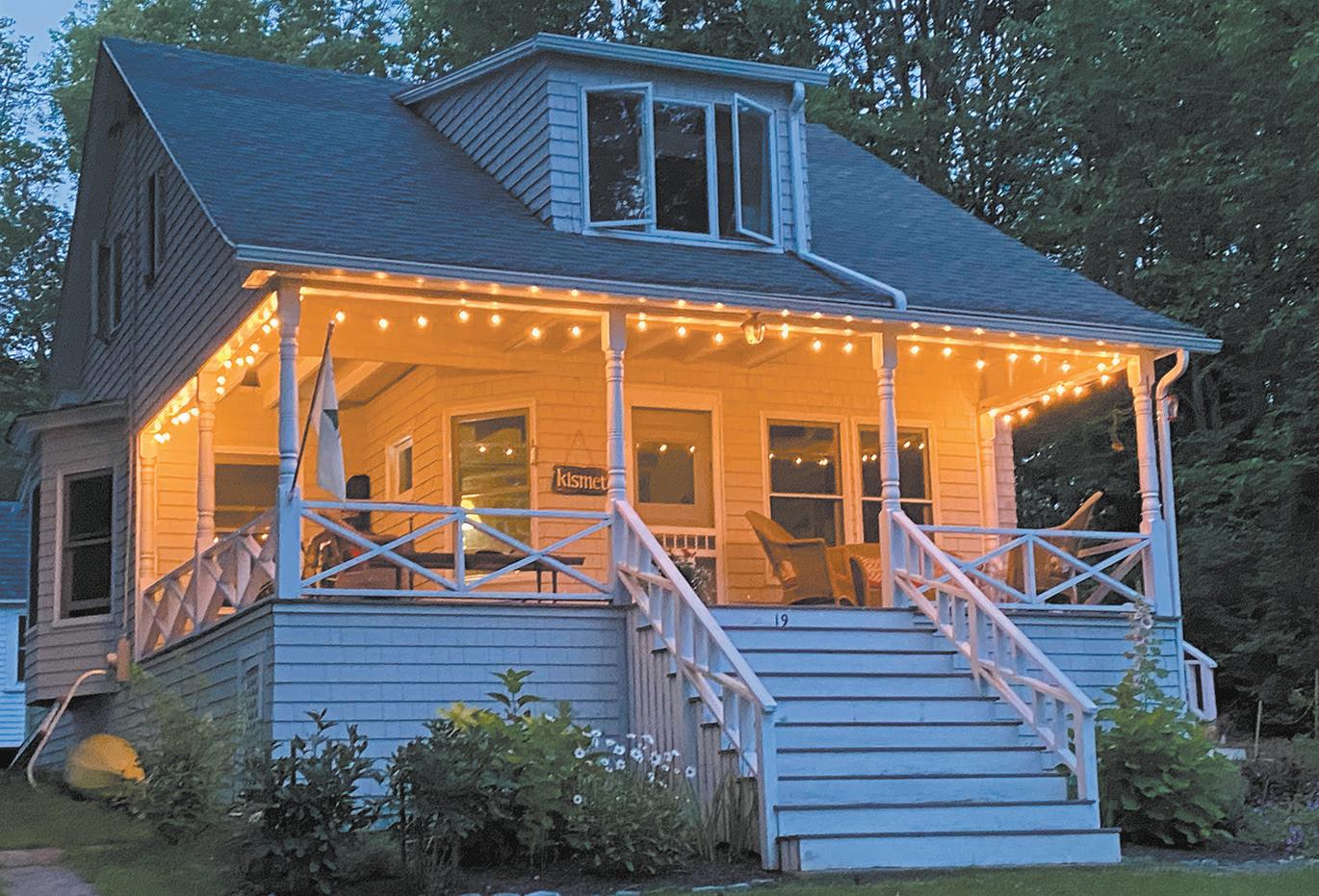
summer storms, the constant drum of the falling rain on the wooden rooftop lulls us into deep sleep.
A small living room features an old woodstove for shoulder season heat, shelves of ever-changing books to read, and a trunk full of board games to play. A cushioned window seat, out of which crawls an occasional black wood spider, provides a cozy napping and reading nook. Sometimes a late summer bat sneaks in at night through the cracks of the wooden walls, and we all shriek as we help the bat look for an exit.
A recent kitchen expansion brought in more light, room to cook, and a water view out a new window. During the kitchen reconstruction, the mice lost their highway into the food pantry, and the new floor blocked the summer slugs from wiggling their way up to the kitchen floor.
Climbing up the steep rust-painted steps, we steady ourselves with a ship rope installed along the side wall. At the top of the stairs, a book shelf of children’s books and buckets full of colorful Legos invite little ones to linger.
Two of the three bedrooms offer new, firm beds, but the third still has the old single mattresses that curl up around the sleeper like a soft taco. Colorful quilts, bright pillows, and area rugs invite family and friends to rest peacefully for the night. During
“Punkin” Lemoine



The long front yard has been the site of home run derbies, tennis ball tosses to pups who are no longer with us, water balloon fights, and games of ladder toss and croquet.
The grass has grown green and lush over the years. The backyard now supports a large, accessible deck. The old shed has been gracefully expanded into a workshop for repairing
With each passing year, I have grown more connected to the island life and to this cottage, in particular.
screen doors and broken chairs and for creating new projects. The three blueberry bushes from the side yard that never produced berries have been donated to a better gardener, and the deer have eaten all the hostas along the winding, wet driveway. Daffodils and purple allium now bloom in the spring around the cottage. In the early summer, deep red and pink peonies and bright blue and white

hydrangeas flourish in the new flower beds on either side of the front steps, a garden created with the help of good neighbors.
I used to say good-bye to the cottage at the end of each Labor Day when I headed back to teach school in New Hampshire, but now in retirement, I come out earlier in May and linger longer though October. Each year I wonder as I leave Long Island what changes winter may bring to our family and the world: my older son’s happy wedding, the sudden death of a dear island friend, the arrival of two grandchildren, the passing of my aging parents, a family divorce, a rich love late in life, a car accident, my younger son’s joyful marriage.
Already this year, fierce winter storms have brought snow, strong winds, and high ocean tides, damaging beach dunes, pathways, and cottages built close to the shore. In retirement, I now live in South Portland just a ferry boat ride away from the island.
Sometimes I venture out to take a snowy winter walk along the island beaches or to visit the community library. I first explored Long Island in the summer of 1981 to visit friends with my newborn baby boy. With each passing year, I have grown more connected to the island life and to this cottage, in particular.
Kismet holds the love, laughter, and tears of my family. The uncertainty of life, just like the unpredictable force of nature, reminds us that nothing remains the same.
Sometimes we welcome the changes; other times we struggle to move forward. Each year, however, when the sun grows warm again, we gather in the Kismet cottage to find peace and rest and a life of joy by the sea.
Candice Dale grew up in Iran, Egypt, Turkey, Italy, and the Washington D.C. area. She taught humanities at St. Paul’s School in Concord, N.H. for 29 years. In 1988, her family bought a cottage on Long Island where they enjoy summers. She now lives in South Portland.

13 www.workingwaterfront.com april 2024 G.F. Johnston & Associates Concept Through Construction 12 Apple Lane, Unit #3, PO Box 197, Southwest Harbor, ME 04679 Phone 207-244-1200— ww w. gfjcivilconsult.com — Consulting Civil Engineers • Regulatory permitting • Land evaluation • Project management • Site Planning • Sewer and water supply systems • Pier and wharf permitting and design
John Martin, Bud Staples, and Elsie Gillespie chat around the woodstove at the annual town meeting.
13 www.workingwaterfront.com April 2020
Gerald
Bud Staples
guest column
The cottage as it looked in 1988
From the ashes, Port Clyde rebuilds
Iconic waterfront recovers after fire
PHOTO ESSAY BY JACK SULLIVAN
Afire devastated Port Clyde’s working waterfront on Sept. 28, destroying three waterfront buildings, the Monhegan Boat Line ticket office and gift shop, the Port Clyde General Store, and the Dipnet restaurant. Five months later, the waterfront is being rebuilt, preparing for the busy summer season ahead.
“Things are going smoothly,” reported Amy Barstow, who with her husband Andy owns and operates Monhegan Boat Line. “We hope to be done rebuilding the ticket office and gift shop by April before ticket sales pick up in May.” Monhegan Boat Line provides year-round transport for passengers and freight to the Monhegan community, ten miles out to sea. The business has temporarily been operating out of its offices across the street which are not as accommodating to a large volume of customers and does not have room for retail sales.
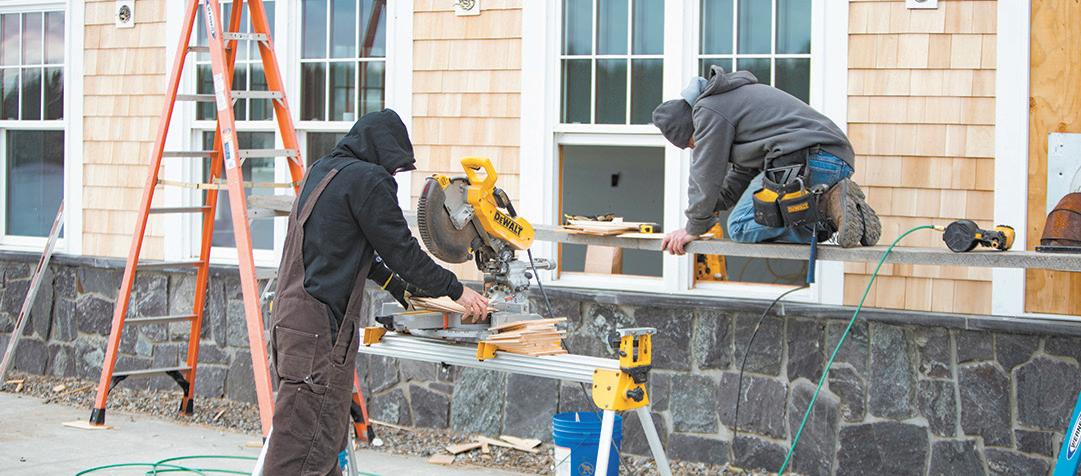
The building under construction is an almost exact replica of the one that burned. The original was built just three years ago as part of a larger construction project that included a seawall and a dock, which escaped damage from the fire.
The other two buildings that were destroyed were owned by Linda Bean. The Port Clyde General Store will be operating out of the Monhegan Boat Line building for at least the upcoming summer season. While there are plans to rebuild the general store, Bean was not available to provide clarity on the timeline of that construction.


14 The Working Waterfront april 2024
Andy and Amy Barstow, owners of Monhegan Boat Line.
The Monhegan Boat Line ticket office and gift shop is on its way to completion.

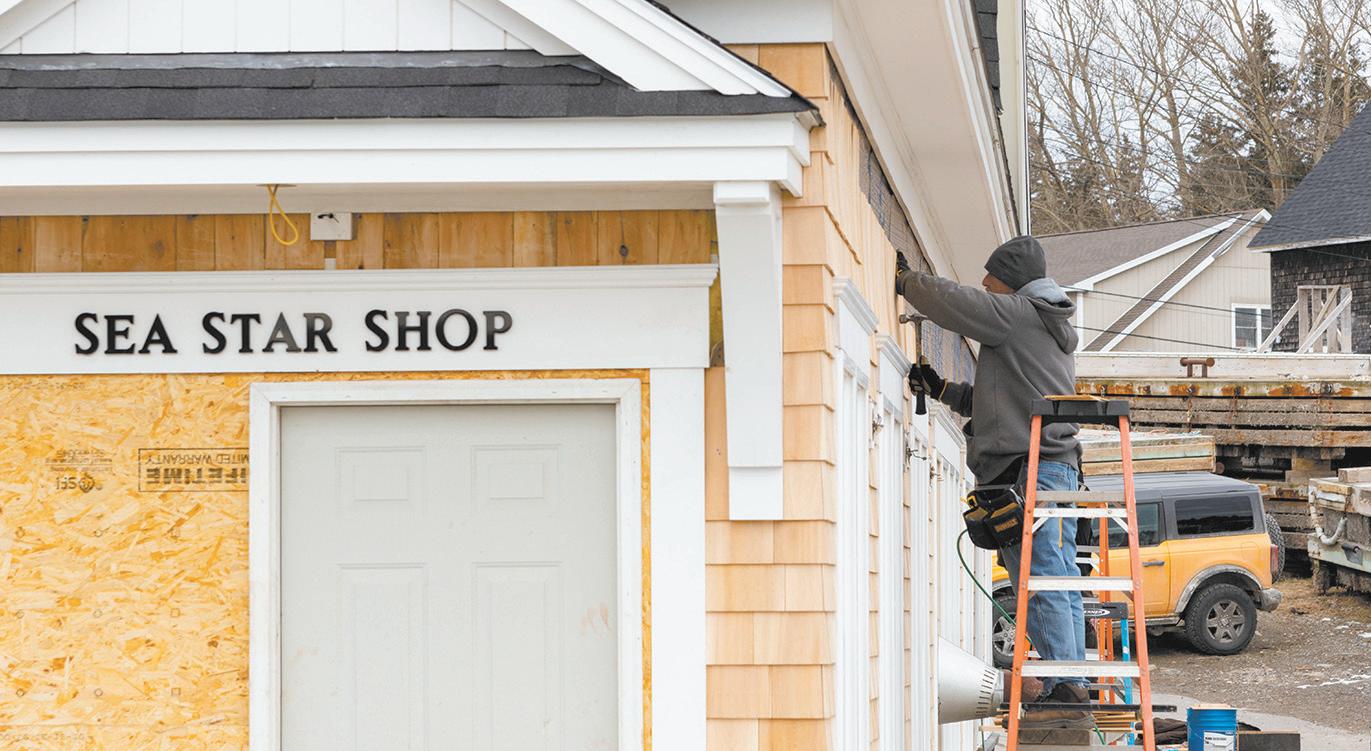

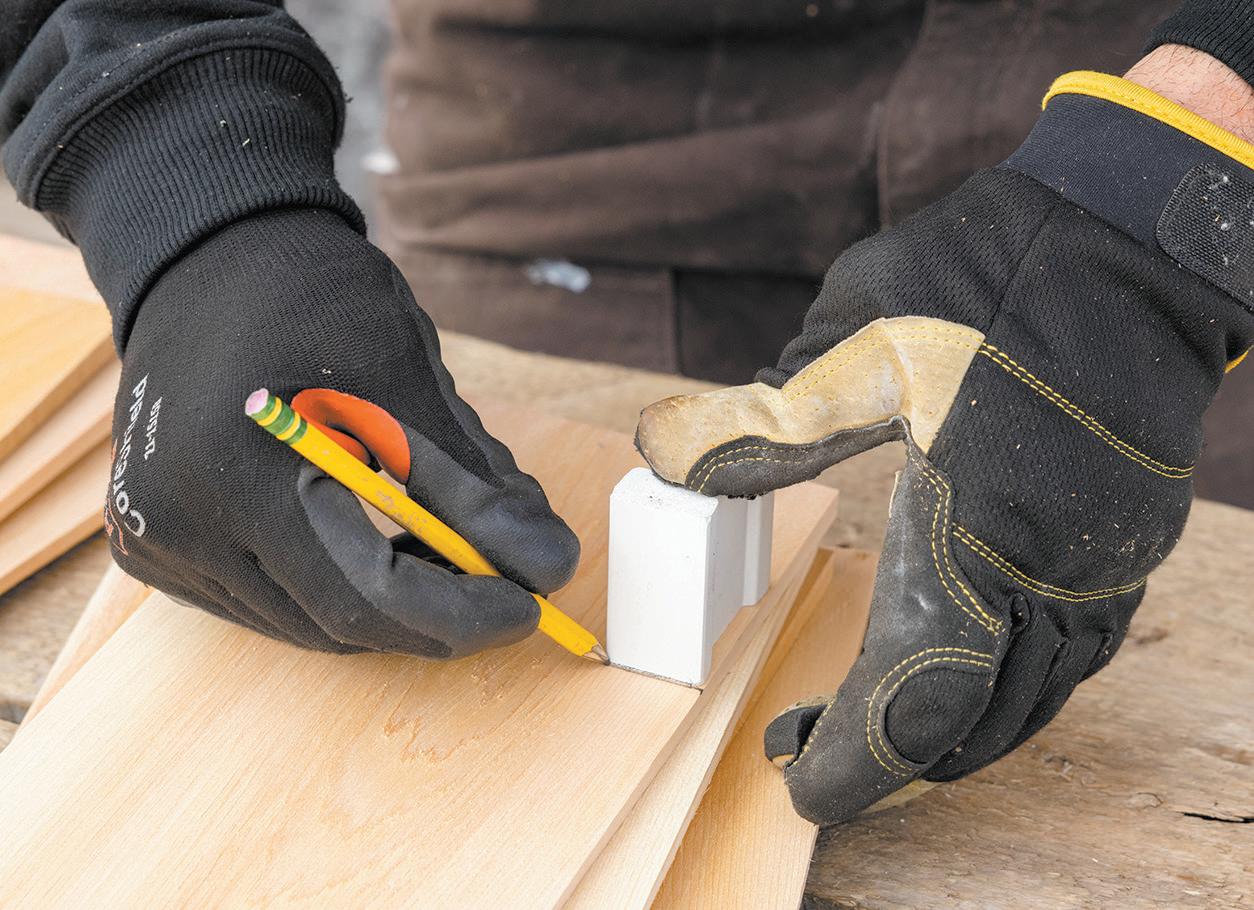

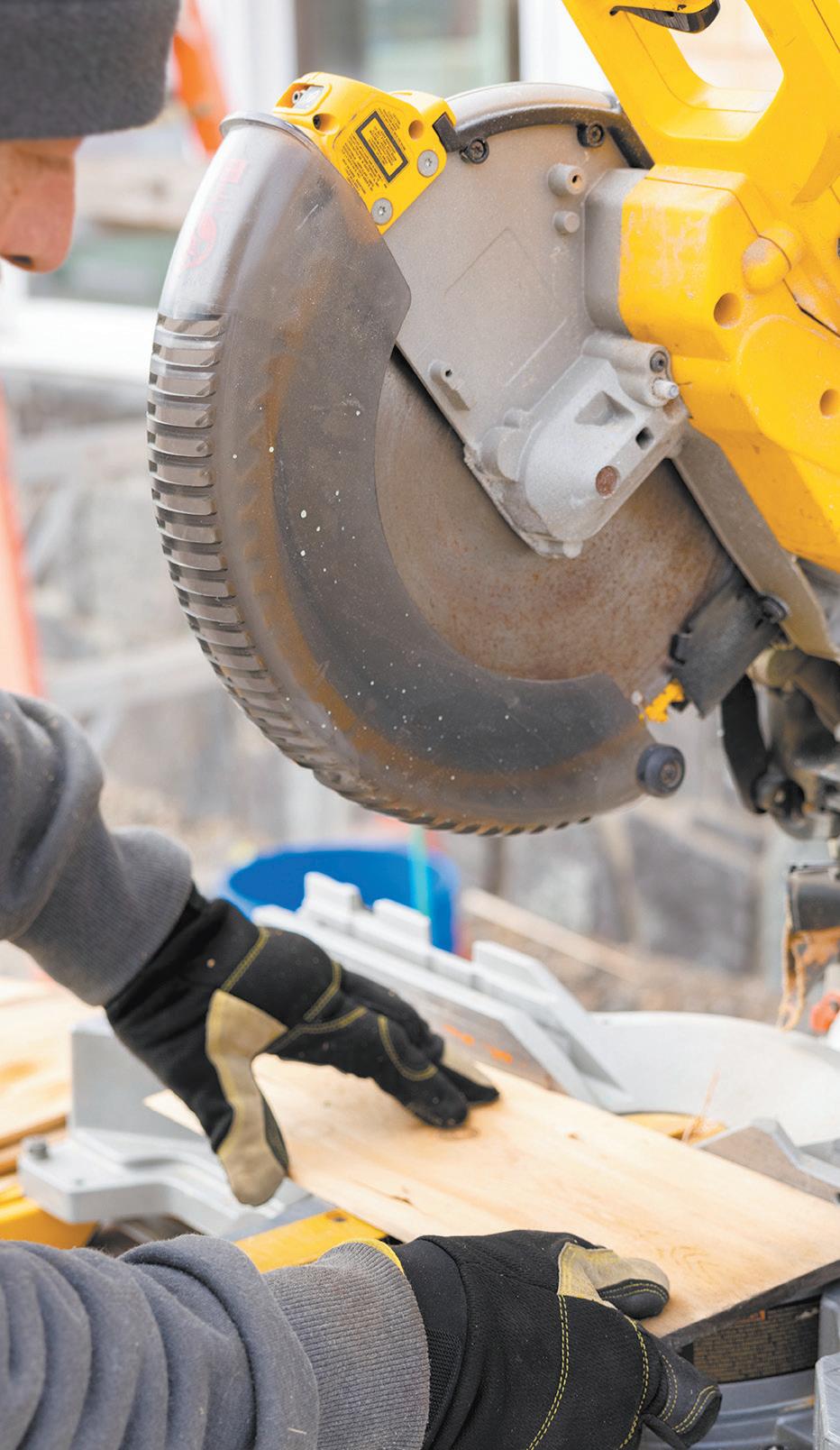
15 www.workingwaterfront.com april 2024
Cameron Johnson applies plaster to the ceiling of the Sea Star Shop while on stilts.
Noah Hall, 20, a Monhegan Boat Line employee, is training to become a ferry captain. He has spent part of the winter helping rebuild the ticket office and gift store.
Installing siding on the new ticket office and gift shop known as the Sea Star Shop.
A worker pays close attention to the detailed trim before placing shingles.
Cameron and Michael Johnson are a father-son team installing drywall.
Cutting shingles for the new building’s siding.
Our Island Communities

ON THE RECORD WITH… Cliff Island’s Bonnie Rideout
Musician
is managing MS and inspiring the next generation.
BY KAI HOLLOWAY
Bonnie Rideout’s house on Cliff Island is on a small bluff jutting to the south, ringed by steep shale cliffs descending into the ocean. The house was used in the filming of The Whales of August in 1987.
Rideout gave me a quick tour of the old house, showing me an antique ice box and 4-foot-tall 1940s radio before we sat down for our conversation on the deck, where I marveled at the view of Jewel Island, wrapped in a thin curtain of fog.
The interview has been edited for length and clarity.
The Working Waterfront: Can you tell me about what style of music you play?
Bonnie Rideout: I play Celtic music. But specifically, the Celtic music I play is Scottish fiddle.
WW: What makes Scottish music unique?
Rideout: Stylistically, Scottish fiddle music was often influenced by the bagpipes as well as the Gaelic language and even dance. So, the ornamentation is unique.
Scottish fiddle music has such a rich history. People would compose and write the music down, as opposed to it strictly being passed down in the oral tradition.
It was influenced by art music in Europe, so it comes out of a tradition of really fine composers and is artistically and technically very well developed. It is also a dance music and there’s certain dances in Scotland that are unique only to Scotland. I love the ancientness of it.
WW: When did you first decide you wanted to be a musician?
Rideout: Music was a way of life in my family. We always played it, especially when we were down here on the island. We had no television. We played music as entertainment, so it was something we always did.
But I wanted to be a veterinarian until high school when I started to realize being a veterinarian was a science. I realized biochemistry was not my thing. I probably started getting really serious into thinking about it as an occupation in high school.
WW: Who are some people who inspired you?
Rideout: I just completed a series to be submitted to the Library of Congress. The two people I chose as influences are both in their 80s.
Chester Pettengill lives on the island. I’ve played with him ever since I was eight years old. We’ve played in the island church every year. We do the hymn-sings and play at the Sunday services.
The other person, of course, is my mother. My mother has taught piano for 55 years and she was my very first influence. I did a recording with her and it just came out this year. She’s 84. She started composing when she was 78. You’re never too old to learn something new.
Within the genre, I lived in Scotland and performed with a lot of Scottish fiddlers there.
I compose most of my music when I’m here on Cliff Island. I recorded one of my albums out in the tower on Jewel Island. We brought a recording crew out there. The tower had splendid natural acoustics. A storm came up during the session and we recorded it while I played. It was magic and we kept it for the last track which ends just with the rain and distant thunder.
I think of Cliff Island as my thinking place. It inspires me, the nature, and of course the people are really special to me. How often do you see and know people your entire life since you were a little kid?
Some people have known me since I was born. And I’ve known people since they were born. When you have a cohesion like that in your life, it helps you to slow down and to reflect and think and be inspired.
WW: How has the music industry changed since you began recording?
Rideout: It’s a sad story. For a lot of musicians, we have had to reinvent ourselves. But some of the ways technology has changed things are good. For example, when I was first recording, you had to be at a certain high level. To go into a studio to record, you had to be backed by record labels. Now anyone can sit in their living room, record, and put their music out there.
I think access to music has improved a lot for just the average listener. It’s more difficult for a musician though to earn a living now. People used to buy their products—tapes, CDs. When I would go touring—I toured for 30 years—sometimes you only got a small amount of pay when you played in a concert hall, but you could make up for it by selling merchandise.
Now, people download it online. All my recordings are on iTunes and all of those platforms, but my royalties have practically dried up.
WW: Could you tell me more about why you had to stop touring?
Rideout: The day I was diagnosed was an unfortunate day. It was Sept. 12, 2001, the day after the 9/11 attacks. I got a call from the doctor. I had gone in for tests because I had all these symptoms that were just not adding up. I had all this tingling in my hands. I was losing my balance. I just kept blaming it on stress.
But I went in for an MRI and they saw the lesions in my brain. They finally diagnosed me with multiple sclerosis.
I toured for another few years because my agent booked me out two years in advance, so I had to fulfill all my obligations. But with MS, I will have an episode where I lose control of the right side of my body. When I have an episode, I can’t feel my right leg at all, so I’m pretty much paralyzed on my right side. And the tremors come.

It’s triggered by heat, fatigue, and stress, all factors in a musician’s touring life. You’re always tired. You’re

always getting hot on stage, and the stress is tremendous. I never could predict when I was going to have an episode. If there’s a 3,000-seat hall sold out and suddenly I can’t hold my violin, that’s a problem.
I’ve managed my MS without medications so far by just basically changing my lifestyle. If I start to overheat, I just go in the ocean to stay cool. The island is a lower stressed lifestyle.
I’m still playing my music and still composing. On good days I record.
WW: What advice would you give to musicians that are trying to start their career?
Rideout: I have thought a lot about this and I feel pretty strongly about it. I took a relatively obscure genre of music and wound up playing in the Kennedy Center and many more major venues. I would say what got me where I am and gave me the career I have was learning more than just music.
When you go to music school—I went to music school—you spend all your time honing your craft. What I advise musicians to do is to take a business class to understand the industry. It’s understanding people, working with people, humbling yourself, and asking for help along the way.
My least favorite part of music is self-promotion. But you have to get yourself out there and you have to promote yourself because no one else is going to do it.
When you’re on the road it takes all year to put together a tour. I’m hiring tour buses, and I got road managers, and I’ve got venue people to work with. What you see on stage is 1/10 of what I do offstage.
WW: Could you tell me about your newest project?
Rideout: I’m working on a project I hope to come out maybe in a year about the Scottish music of George Washington. I’ve been doing research for a couple of years on and off at Mount Vernon, which is right up the road from where I live in the winter in Alexandria, Virg.
Some of these songs were in Martha Washington’s music books. She also played the harpsichord, as did her daughter and granddaughter. I discovered a few things that haven’t been noticed in the manuscripts before. I’m working on a recording with violin, harpsichord, and cello. Hopefully it will either be recorded at Mount Vernon or up at Bowdoin College.
Read more of Kai Holloway’s writing at his blog at www.kaioutside.com.
16 The Working Waterfront april 2024
Bonnie Rideout with Chester Pettengill, a musician she has played with for years.
PHOTO: CHRIS MOSCATIELLO
Bonnie Rideout
Islesboro’s Olivia Britton serving on UMaine board
Second-year student represents other students
BY STEFFI VICTORIA
This story first appeared in The Maine Campus, the University of Maine’s student newspaper, and is reprinted with permission and gratitude.
Public institutions, and the boards that manage them, can too easily lose sight of the concerns and perspectives of those who are served by the organization. In the case of the University of Maine, the board of trustees aims to avoid that fate by including a student representative as a member.
Currently, that seat is held by Olivia Britton of Islesboro. Britton’s role is to amplify student perspectives before trustees finalize decisions affecting campus life.
Britton is a second-year civil engineering and political science student. Initially, she was interested in UMaine student government but a recent board report summarizing ongoing projects captured her attention.
“I learned a bunch of things that I did not know were happening on campus and system wide,” she said. “I want that information to be as accessible as possible.”
Britton aims to improve what she sees as information-sharing inconsistencies between trustees and students,
as well as serving as an “access point” for the student body to feel heard.
“The decisions that happen at the board level, even though they are sometimes complicated and a little bit confusing, affect our everyday lives,” Britton said, referencing recent board discussions about campus housing and dining. “It’s important for student voices to be heard in those conversations.”
Student board representatives are the go-between for students with questions and recommendations for trustees to consider before finalizing executive actions.
Recently, Britton met with student government executives and senators to address concerns raised at the Jan. 29 trustees meeting.
“It was clear that students were confused and wanted to know what was happening,” Britton explained, citing the conversion of the Estabrooke dorm into an office facility. “It’s a bummer that space won’t be for students anymore.”
Other dormitories are being renovated, and Hart and Hancock halls, which are also dorms, will soon occupy additional spaces to improve living standards by featuring singleuse bathrooms, kitchen areas, and other facility advancements.
“I can’t wait for students to have that space,” Britton said.
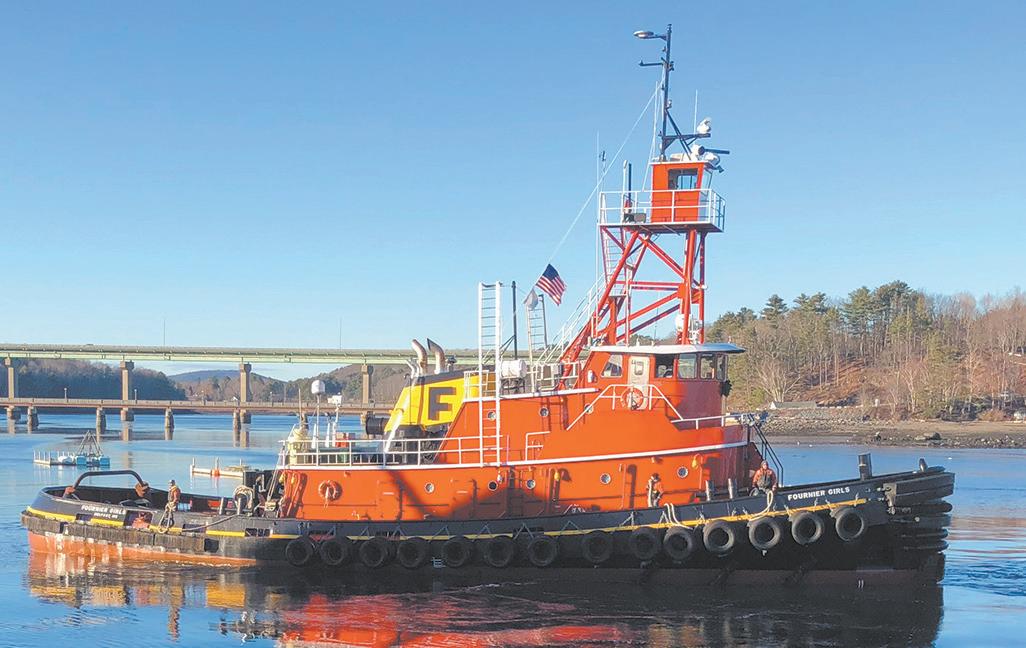
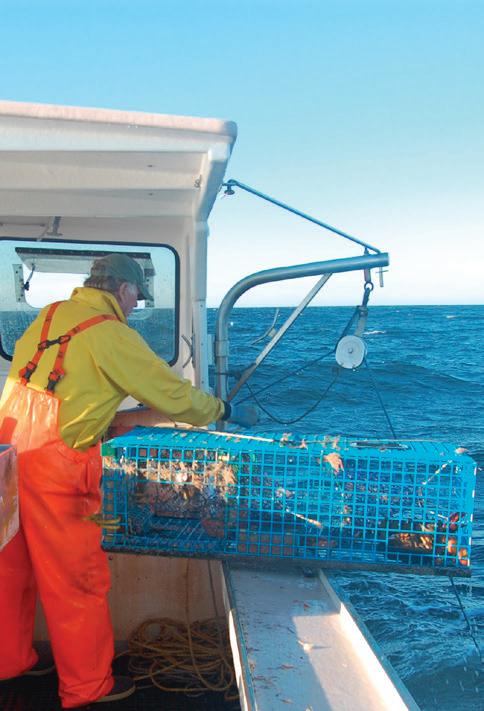



The dorm renovation plans were not available for public review before the Jan. 29 trustee executive session. Students criticized the board’s decision on Estabrooke Hall.
“It’s really unfortunate that the information did not all come out at the same time because it, rightfully so, felt like things were being taken away from students,” Britton said.
She strives to cultivate a community network with other student representatives and leaders throughout the University of Maine system, she added, and works to grow as a leader in her new role.
“I’m excited to make a really strong foundation for the other representatives to be as effective as they can,” she said. “I want to do as much listening to the student body as I can because they spend more time here than I do and have a better understanding of what their needs are,” she said.
Britton explained that her top priority in this position is to regularly consult with students, offering them a receptive avenue to raise important issues before sharing them with trustees.
“Before I come up with my own changes, I want to do a good job of listening first. I would love to hear any thoughts about what life is like on campus and questions about where



 Olivia Britton
Olivia Britton
money is being spent and how decisions are being made,” she said.
Britton’s active membership of the executive board of undergraduate student government entails attending every board meeting with other UMaine system campus representatives, including eight-hour sessions which convene once every two months, and attending the senate, executive, and cabinet meetings. She then submits her reports to the UMaine student government.
All student members of the board are appointed for a single two-year term. Britton will fulfill her term requirements by spring 2025.
Britton is also a member of the Society for Women Engineers and Partners for World Health. In addition, she serves as the Diversity Equity and Inclusion (DEI) chair in the Chi Omega Sorority.






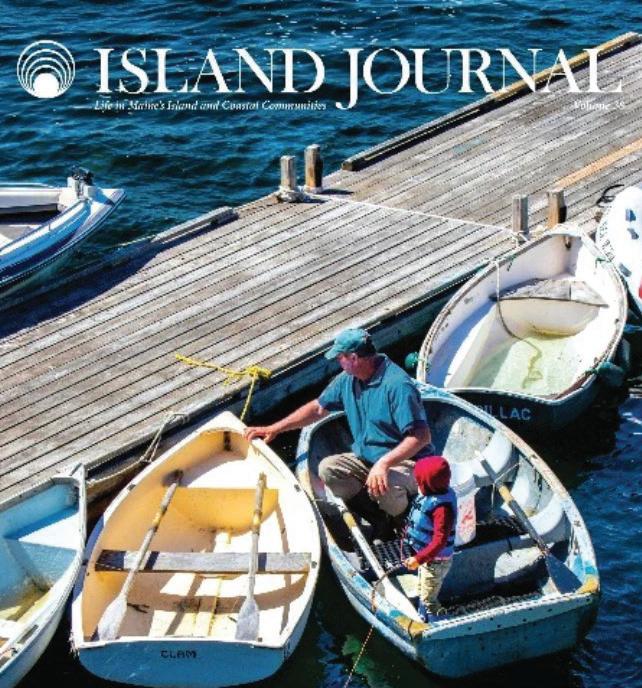



17 www.workingwaterfront.com april 2024 Sea Farm & Commercial Fisheries Loans FINANCING FOR MAINE’S MARINE BUSINESSES For more information contact: Nick Branchina | nick.branchina@ceimaine.org | (207) 292-1250 Hugh Cowperthwaite | hugh.cowperthwaite@ceimaine.org | (207) 292-1102 Funds can be utilized for boats, gear, equipment, infrastructure, land and/or operational capital. Discover Maine Art, Discover Maine Craft 386 Main Street, Rockland ME 04841 | 207-596-0701 Top Left to Bottom Right: Swans Island, Lisa Gent, Shanna Wheelock, Island Institute, Margaret Olson, Hearth & Harrow, Nancie Morgan, Kelly Luger, Pam Cabanas, Island Institute, Zootility, Kurier Tuesday - Saturday 10 - 5 | TheArchipelago.net
The Fournier Girls, a tow boat in the Fournier Tugs’ fleet, returns to its dock in Belfast.
PHOTO: TOM GROENING
New seafood markets emerging
Flounder, other groundfish embraced by immigrants
BY TOM GROENING
THE OUTLOOK FOR groundfish as a source of revenue for fishermen and protein for consumers has been gloomy at best. But according to a presentation at the Maine Fishermen’s Forum on March 1, there are untapped markets that may be cause for optimism.
Merritt Carey, who for four years has worked with SEA Maine—the Seafood Economic Accelerator for Maine, an industry-led initiative—highlighted the recent report the group published that provides a roadmap for growth for the sector.
Carey moderated a panel at which the report’s key points were explained. Under the heading “Seafood Markets and Marketing: What Are We Missing?” panelists used the report’s data to point to niches that are underserved.
Janine Cary of the Maine Center for Entrepreneurs said nationally, seafood sales over eight species were down 3.7% in 2023 over the previous year, though the data didn’t include the fourth quarter.
The pandemic was a factor in some of the recent data, she and others said.
Bright spots included more frozen flounder selling in interior states, while South Atlantic and Mid-Atlantic states also were consuming more seafood.
“Those two markets are growing a lot,” Cary said. “They eat a lot of seafood.”
Seafood sold by a handful of large food service suppliers—selling to restaurants and institutions like hospitals and nursing homes—fell by 22.6% through July of last year, she said, some of which is attributed to inflation.
The 2023 overview, she said, was not good, with fresh seafood sales down by 16.8%, frozen seafood down 14.9%, and shelf stable seafood down 9.1%.
Today, there are 22 million Americans whose families came from Southeast Asia, Chong said, and by 2060, Asian American immigrants will be the largest minority in the U.S., surpassing Hispanics. That population has quadrupled since 2000, he added.
Every large U.S. city now has a “minority majority” population, he added.
“People of color are eating far more seafood.”
If there is a path toward boosting consumption consistently, Tae Chong, director of multicultural marketing and strategies for the Maine State Chamber of Commerce, provided it.
“The demographics are changing,” he said. “People of color are eating far more seafood. They also consume a diversity of seafood.”
U.S. residents on average consume 16 pounds of seafood annually, while Cambodians consume an average of 92 pounds annually. There are 35,000 people of Cambodian descent living in Lowell, Mass., Chong said, a community that was the subject of study.
Data gathered in Portland shows the average monthly grocery bill at $1,211, with $68 devoted to seafood. The average household there ate seafood at home 2.8 times a month.
By comparison, the population surveyed in Lowell spent $932 a month on groceries, with seafood accounting for $171. Households ate seafood at home 12.8 times a month.
Ben Martens, director of Maine Coast Fishermen’s Association, highlighted flounder as “one of the success stories we’re seeing in our ocean.” Yet in December, some 30,000 pounds of the fish landed in Maine was sold for $1 per pound.
“We need to diversify,” he said, so fishermen can find new species to catch, matched to new markets.
Waterfront access jeopardized by storms
Lost piers may not be replaced, properties sold
BY TOM GROENING
The challenges of maintaining working waterfront access was the topic of a discussion at the Maine Fishermen’s Forum on March 2, scheduled well before the January storms that pummeled the Maine coast. And that was appropriate, given the shrinking footprint the marine economy faces.
But a panel discussion on the matter took on a decidedly urgent and dire tone, as those close to the issue described how storm damage may have reversed efforts to preserve these critical properties.
The discussion began on a positive note with Department of Marine Resources Commissioner Patrick Keliher, who serves on the Land For Maine’s Future board, reporting that “a fairly significant” number of conservation covenants have been placed on working waterfront properties, thereby protecting them for marine use. An application deadline for $2.1 million in land protection funds had just closed, he added.
unchanged from the air actually were where wharfs had been washed away.
Sadly, he said, federal recovery money may not be accessible for private wharves, and FEMA and Economic Development Administration funds also “are not a good fit.”
Keliher reminded those attending to support LD 2225 in the Maine Legislature which, as proposed, would dedicate $20 million to working waterfront recovery work.
“ We’re going to see a second wave from these storms,” she said, as access narrows.

“We have fish in the ocean,” he said, with marine scientists saying that 30 million pounds of fish in the Gulf of Maine could be landed that are not being caught.
Seaweeds also hold potential for growth, said panelist Liz MacDonald of Atlantic Sea Farms. With a $17.8 billion global market in 2022, Maine growers have opportunity, she said. Seaweed snacks are being embraced by millennials, she said, and campus food services, along with hospitals and nursing homes, are including seaweed “for a healthier option.”
To read the full SEA Maine report, visit: seamaine.org/reports-presentations.
Keliher described taking a helicopter tour of the coast to assess damages and described scenes “like a war zone.” Some areas that looked
Moderator Natalie Springuel of Maine Sea Grant said that “Maine has a long-term commitment to working waterfronts,” noting that the state’s working waterfront coalition became a model for other states.
The panel included Monique Coombs of Maine Coast Fishermen’s Association, who lives in Harpswell and described how that peninsula town was hit by the storms.
Jan. 13 was her birthday, she said, and as she and her husband drove around to survey the damage, “It was completely heart-breaking.” The wharf her family once owned was lost, she said, and it was linked to many family livelihoods.
In May and June, when fishermen begin putting their lobster gear in the water, “We’re going to see a second wave from these storms,” she said, as access narrows.

Emily Farr, who works to support shell fishing in Casco Bay for the Brunswick-based nonprofit Manomet, said the storm left debris or washed out many of the footpaths used to access mudflats. Two-thirds of that access is on private property and was offered on a handshake arrangement, she added, meaning that if property ownership changes, access could be eliminated.
In fact, Farr and others said, private wharves destroyed by the storm could create a wave of waterfront property sales which would convert those sites to residential use. Panelists also noted that those who used those private access points now would go to public sites, creating competition and possibly conflict.
Panelist Tad Miller’s family bought a wharf in Tenants Harbor
in 1975, he said, and storm damage to the family wharf was significant.
“I would like to see a grant fund,” to pay for repairs, or a low-interest revolving loan fund.
Panelist Rebecca Rundquist is a founder of Sea Meadow Marine Foundation in Yarmouth, an allvolunteer nonprofit that preserved a marina and working waterfront landing on the Cousins River. The property is used by rowing clubs, small boats, and shellfish growers, she said.
Coastal Enterprises Inc., or CEI, was instrumental in helping the group secure the property. But Rundquist said the issues facing these properties, private or not, are urgent.
“We’re already ten years too late,” she said, and proposed a statewide conference at which working waterfront issues could be discussed.
18 The Working Waterfront april 2024
We want to hear from you!
As Island Institute seeks to continually improve The Working Waterfront’s content and reach new audiences, hearing from readers is a critical part of that process. To help us in these efforts, Island Institute is working with an independent market research firm in Maine (Digital Research, Inc. or ‘DRI’) to conduct a survey about readers’ thoughts and feelings on The Working Waterfront. We value your input and thank you for taking part in this important initiative.
How do you get your news of Maine’s coast and islands?
How often do you access the following resources for news and information about Maine’s island and coastal communities?
NOT AT ALL A LITTLE OCCASIONALLY REGULARLY DON’T KNOW
Local television news
Maine Public radio Bangor Daily News Ellsworth American
PenBay Pilot Portland Press Herald
Quoddy Tides
The Maine Monitor
Penobscot Bay Press
The Working Waterfront
Other local weekly community newspapers Online newsletters or email distributions from community organizations
Which one resource do you trust most for news and information about Maine’s island and coastal communities?
Local television news
Maine Public radio
Ellsworth American
PenBay Pilot
Portland Press Herald
Quoddy Tides
The Maine Monitor
Penobscot Bay Press
The Working Waterfront
Other local weekly community newspapers
Online newsletters or email distributions from community organizations
Some other source of information not mentioned
Specify: ____________________________________________________
None of these resources
Don’t know / Don’t recall
Thinking about the various resources providing coverage of Maine’s island and coastal communities, what topics do you believe should receive more or better coverage?
Arts/Culture/Lifestyle
Climate issues/Impacts of sea level rise
Opinion and editorial commentary
Economy/Marine economy
Environment/Land use/Sustainability
Fishing/Marine issues
History/Maritime history
Housing issues/Workforce housing
Tourism management
Changes impacting lobstering industry
Schools/Education issues
Some other topic(s) not mentioned
Specify: ______________________________________________________
None/No changes needed
Don’t know/Don’t recall
You may choose one of several ways to take part:
1 – Scan the QR code to directly link to DRI’s secure survey portal, then follow the instructions.

2 – Type the following address into an internet browser to directly link to the secure survey portal: Digitalresearch.com/WWFsurvey6
3 – Clip and return this paper survey and return directly to DRI for processing: DRI 172 Commercial Street Portland, Maine 04101
SURVEY CLOSES MARCH 28!
All participants in the survey are eligible to win one of three $100 gift certificates to Archipelago, Island Institute’s store that supports Maine’s creative economy. Please provide a contact email address or phone number so that we may contact you. This information will only be used for the purposes of providing an entry into this random drawing and for contacting any winners.
EMAIL:
PHONE:
Tell us your experience with The Working Waterfront
The Working Waterfront is published in its current newspaper format 10 times a year. In a typical year, about how often do you read The Working Waterfront?
All the time / Every issue
Most issues
Some issues
Only a few issues
Never
When you read The Working Waterfront, about how much of the publication do you typically read?
All of it
Most of it
Some of it
Only a bit of it / Selected articles
None
Tell us about the things covered in The Working Waterfront
Please think about the topics typically covered in The Working Waterfront. The publication is informed by knowing what matters most to readers, so please tell us how interested you are in reading coverage in the following topic areas.
NOT AT ALL NOT
Fishing/Marine issues
History/Maritime history
News and opinion from Island Institute
Photo features
Housing issues/ Workforce housing Tourism management
Changes impacting lobstering industry
Schools/Education issues
19 www.workingwaterfront.com april 2024
VERY SOMEWHAT VERY DON’T INTERESTED INTERESTED INTERESTED INTERESTED KNOW Arts/Culture/Lifestyle Climate issues/ Impacts of sea level rise Opinion and editorial commentary Economy/Marine economy Environment/Land use/ Sustainability
Continued
on next page
Continued from prevous page
Would you like to see less, the same amount, or more coverage of the following topic areas in The Working Waterfront?
Arts/Culture/Lifestyle
Climate issues/Impacts of sea level rise
Opinion and editorial commentary
Economy/Marine economy
Environment/Land use/Sustainability
Fishing/Marine issues
History/Maritime history
News and opinion from Island Institute
Photo features
Housing issues/Workforce housing
Tourism management
Changes impacting lobstering industry
Schools/Education issues
Thinking about the type of coverage available in The Working Waterfront, which three of the following types of content or aspects of coverage in the publication do you find most important?
Local stories of Maine coastal life
In-depth or longer form stories on topical issues
Your familiarity with the publication’s longstanding contributors
Stories that provide an understanding of the work of Island Institute
Stories about the community where you live
Being able to connect to coastal communities when you are away from Maine
The breadth of the publication’s coverage
Quality of the writing and analysis
Quality of the photography
Unique coverage not available anywhere else
Don’t know
Tell us how you interact with The Working Waterfront
Thinking about different options available to read The Working Waterfront, how often do you read content from the publication in the following ways?
NOT
A print copy, mailed directly to you
A print copy, inserted with a copy of a daily newspaper as part of
your subscription to that paper
A print copy available in racks with other newspapers at certain
retail locations
An online version of the printed copy, accessible as a viewable PDF file at
the website for The Working Waterfront
Stories from The Working Waterfront emailed directly
to your inbox
Stories or items from The Working Waterfront seen on social media
or similar sources
Among the current options, which is your preferred way to read The Working Waterfront?
A print copy
An online version of the printed copy, accessible as a viewable PDF on the website
Stories emailed directly to your inbox
Stories or items seen as part of your news feed on social media
In order to create new and expanded content to reach more audiences with the type of storytelling they value most, many publications have moved to a subscription- or donation-based approach to distribution in order to expand their coverage and sustain their operations. The Working Waterfront is considering similar changes in the distribution of the publication. Please tell us how willing you would be to support The Working Waterfront with each of the listed approaches under consideration shown here.
VERY SOMEWHAT SOMEWHAT VERY DON’T UNWILLING UNWILLING WILLING WILLING KNOW
If a modest subscription fee was required to continue receiving the paper in its current print format.
If a charitable contribution to Island Institute was required to continue receiving the paper in its current print format.
If a modest subscription fee was required to receive an online version of the publication with expanded content, access to archival material, video storytelling, and other enhancements.
If a charitable contribution to Island Institute was required to receive an online version of the publication with expanded content, access to archival material, video storytelling, and other enhancements.
An idea under consideration is making The Working Waterfront a publication only available online. If The Working Waterfront were to move solely to an electronic/online publication in order reach more audiences, and in doing so made archival content more easily accessible and also shared some information in a video format, how would this change your readership of the publication?
You would likely read much more than you currently do
You would likely read somewhat more than you currently do
You would likely read somewhat less than you currently do
You would likely read much less than you currently do
Your readership would likely not change
Don’t know / Not sure
Classification Items
Which of the following best captures your principal place of residence?
In Southern coastal Maine, from Kittery up to the Brunswick area
In Midcoast Maine, from Bath up to the Bucksport area
In Downeast Maine, in Hancock or Washington County
In another part of Maine, not along the coast and islands
Outside of Maine
Which of the following best describes your place of residence
Live year-round in Maine
Live seasonally in Maine or spend certain periods of time in Maine
Live outside of Maine
Please select the items below that best reflect how you classify yourself in terms of gender, age and racial background. These items are only asked for classification purposes.
Female
Male
Non-binary or other
Prefer not to say
Younger than age 40
Between the ages of 40 and 64
Age 65 or older
Prefer not to say
Caucasian/White
African American/Black
Hispanic/Latino
Asian
Native or Indigenous
Other
Prefer not to say
20 The Working Waterfront april 2024 20 The Working Waterfront . april 2024
LESS THE SAME MORE DON’T COVERAGE COVERAGE COVERAGE KNOW
ALL A LITTLE OCCASIONALLY REGULARLY DON’T KNOW
AT
book reviews
The state’s largest bay as seen by painters
Latest art collection by Littles offers span of work

Art of Penobscot Bay
By Carl and David Little (Islandport Press)
REVIEW BY
DONNA GOLD
LOOKING THROUGH Art of Penobscot Bay, Carl and David Little’s latest contribution to Maine art, is like viewing a newly discovered family album. From quiet coves to the clanging metal of an unloading ship, the sights and sounds rendered into watercolor and oil carry an excitement of discovery and of memory.
“Look, how commanding the ferry to North Haven seems!”
“Look how the mudflats along the Deer Isle causeway shimmer!”
“And how the low winter sun sets Stonington aglow!”
What a delight to find our everyday vistas thus cherished and transformed by artists.
Poet and writer Carl Little and his brother, the painter David Little, have individually or together celebrated Maine in art through such volumes as Paintings of Maine, Art of Maine Islands, The Art of Maine in Winter, Art of Katahdin, and Art of Acadia. Each is an offering of the region’s beauty and creativity to the world.
Art of Penobscot Bay extends this gift into the heart of Maine’s coast from Rockland to Stonington, from the days of schooner traffic to Vinalhaven’s trio of dancing wind turbines.
The book begins with a selection of painters no longer with us (think Fitz Henry Lane, George Bellows, Marsden Hartley), titled “Yesterday,” and moves on to “Today,” featuring those working within the last 70 years. The accompanying narrative notes salient points about artist and image, adroitly linking one to the next.
Many paintings, whether realist, impressionist, or abstract, mesmerize us with the interplay of quiet coves and wider waters, often dotted with sailboats or lobster boats (though very few speedboats). Yet a pair of images show adolescents so habituated to the bay they have turned their backs to it. Louise Bourne paints her son playing cards on Eagle Island in “Island Solitaire,” while Anina Porter Fuller’s “Game of Chess” portrays two grandsons on Great Spruce Head, the island made famous by her uncles, painter Fairfield Porter and his photographer brother Eliot (both represented in “Yesterday”). A counterpoint to summer respites are laborers, from William Muir’s 1945 “Fish Packing Plant” to Susan Tobey White’s 2018 “Lobstering Women of Maine,” along with heavier industry, represented by two paintings of Searsport’s Mack Point port, one by Nancy Morgan Barnes, another by Stefan Pastuhov.
Some pages had me laughing aloud. Irene Olivieri’s delightful “Studio of the Sea” fancies a lobster boat studio seemingly adrift, with only a cat for a crew as the naked artist swims atop a seal. In Waldo Peirce’s 1966 “Sirens of Searsport”, five nude women attempt to distract a young lobsterman fiercely rowing his dinghy home.
The late Howard Fussiner comically interprets a Brooksville parade honoring children’s author Robert McCloskey, summer resident of nearby Scott Island. Douglas Smith’s “Fuel Tanks with Lobster, Rockland” is just that, a huge red lobster clawing over a large, white tank.

Irene Olivieri’s delightful “Studio of the Sea” fancies a lobster boat studio seemingly adrift, with only a cat for a crew…
While “Yesterday” seamlessly edges into “Today,” presenting an almost unchanging coastline, January’s storms battered many of these waterfronts. Seen against those tides, Allen Lawson’s “The Lobster Pound (2006)—Winter” of the popular Lincolnville restaurant, and renderings of Eaton’s boatyard by George Savary Wasson in 1908 and Gregory Dunham in 2015, remind us of the vulnerability of the pastoral coast against the power of these waters we worship.
Given the abundance of Penobscot Bay art, I can only sympathize with the Littles’ effort to limit this volume to 120 artists and 134 paintings. My only concerns are with design and
production. An artbook with such a range of artists calls for an index, or at least a list of artists. And the pale blue stripe over one third of each page almost acts as a shadow beside the paintings in the “Today” section. But the art shines through. For days now, whether gazing out my window or traveling the region, I see an afterglow of possible paintings. Art of Penobscot Bay deepens our vision of this place we inhabit and leads to imagine what might lie within.
Donna Gold gazes at Penobscot Bay daily from her Stockton Springs hilltop home.
We’re talking about the long-term value that comes from a personalized approach to insurance coverage offering strategic risk reduction and potential premium savings.
Generations of Maine families have looked to Allen Insurance and Financial for a personal approach that brings peace of mind and the very best fit for their unique needs.
We do our best to take care of everything, including staying in touch and being there for you, no matter what.
That’s the Allen Advantage.
21 www.workingwaterfront.com april 2024 A close working relationship with your insurance agent
worth
too.
is
a lot,
Call today. (800) 439-4311 | AllenIF.com Owning a home or business on the coast of Maine has many rewards. We are an independent, employee-owned company with offices in Rockland, Camden, Belfast, Southwest Harbor and Waterville.
MONHEGAN SKIFFS FOR SALE 9 1/2ʹ and 11ʹ plywood and lapstrake — starting at $2,300 ADIRONDACK CHAIRS FOR SALE $300 Call 677-2614 or email director@carpentersboatshop.com
saltwater cure
What will we do with the water?
Adaptation to rising seas raises questions
BY COURTNEY NALIBOFF
THE OCEAN IS knocking at our door. Since the torrential, monsoon-like rain in October, the island has been battered by four additional significant storms. In January, a devastating combination of wind and tide laid waste to Brown’s Boatyard, and took out boathouses, fish houses, docks, and piers. The next storm hit three days later.
The wind and water have always been present, always reminding us of their destructive power, but through a combination of luck and privilege I haven’t experienced that as an existential crisis until recently.
The seaweed still scattered throughout the sailing club walkway and festooning the trees along the Thorofare, the high-water marks on the buildings, the “Pay Inside” sign on
the gas pump—the ocean knocked at the door and reminded us that it’s not really our house.
A potent reminder of the island’s ancient coexistence with the ocean was carved open in the storm—the shell midden at Turner Farm beach. Since the January storms it’s been bleeding spear points, arrowheads, and other artifacts. See what our relationship used to be like?, the ocean says.
The ocean knocked at the door and reminded us that it’s not really our house.
Everybody agrees this is unprecedented, everybody agrees that we want to keep living here, everybody agrees that we need to do something—but what is there to do?
An engineering firm, contracted by the town to start considering what changes can be made to the Thorofare waterfront, held a public meeting at the market a few weeks ago. I walked in to buy groceries and overheard an attendee ask, with a note of desperation, “But what will we do with the water?”
That morning, with not a breath of wind or drop of rain, an astronomical high tide filled the Brown’s lot almost up to the road once again. I had been one of a parade of cars who had driven down hoping to get gas, only to
journal of an island kitchen
The great storms brought great reckoning
Town has head start on adapting to rising seas
BY SANDY OLIVER
LOTS OF US, I learned conversing a day later with friends, woke up around 4:30 on the morning of the great storm, hearing the wind slam around our houses, feeling our sound old homes vibrate with its ferocity.
Wind-whipped electrical wires attached to the house adjacent to my bedroom added to the racket. The door between the kitchen and wood room, latch-less and on a spring so the cat can let himself in and out, slammed time and again. I jammed it shut with the stiff sleeve of a barn jacket hung on a hook nearby.
Prowling from room to room, I found the only damage was a second story window pane had been sucked out and smashed on the ground outside.
There was no such thing as going back to sleep.
Fortunately, we lost no trees here, and our house sited on a high piece of island ground where we cannot even see water, sustained no water damage either from tide or rain. What a good thing the house had a new roof, because this storm would have peeled off the feeble asphalt shingles that covered it until October. For the thousandth time, I blessed my lucky stars that I didn’t own waterfront property.
I live up-island, the north end, past the Narrows, which was beaten up pretty badly in this storm, scattered with rocks, driftwood, seaweed, and beach gravel, and sections of roadway broken loose. Some traffic squeaked through; friends took pictures of waves crashing against a seawall installed years ago by the Army Corps of Engineers, flooding the only connection between North Islesboro and the firehouse, health center, and ambulance service, which are all located mid-island.
The bay lifted up one little cottage and set it down a little farther from the shore than before.
The ferry road, particularly the part closest to the terminal, was swamped at high tide, seawater flowing in from the southwest, Gilkey Harbor side, and from the low-lying northeast side. Plenty of other lowlying spots were underwater for a while, presaging the island’s future as even more of an archipelago than it is now.
Sections of shoreside lanes unprotected by rip-rap washed out, some homes saw water creep a heck of a lot closer than ever before and one

pull out quickly upon realizing the lot was under water. I checked my tide app before making a second attempt. That was a first—maybe not a last.
So what will we do with the water?
Can we raise ourselves up high enough, make our structures strong enough, pump it out fast enough? Change our routines, our expectations, our relationship with the ocean? Will it let us remain its tenants, or evict us and decorate its properties with rockweed welcome mats for the new residents?
Courtney Naliboff teaches writing, theater, and music on North Haven and plays in the band Bait Bag. She may be contacted at Courtney.Naliboff@gmail.com.
friend reported being astonished at seeing waves splash against her living room windows.
The bay lifted up one little cottage and set it down a little farther from the shore than before. Nature inelegantly accomplished what the owner reckoned he would have to do anyway.
Still, Islesboro was spared the awful waterfront damage to fishing businesses that happened in Stonington and other spots. For years, fishing here is largely conducted from floats moored in Gilkey with fish shacks on them, reached by small boats from the town pier.
One yacht yard, though, reported seeing water where it has never been before; the other yard is located at the top of a hill which will never see water even if Antarctica melts. That yard hauls boats all the way down a long steep road to launch them into a cove.
None of the flooding here surprised. Quite a few years ago, when I was still on the select board, the town hired a company to model likely sea level rise scenarios, and its report showed us where we could expect to see high water. During this storm, flooding occurred right in the places predicted.
Fortunately, in November 2019, Islesboro established a town sea level rise committee which has charged engineers with finding ways to keep the island connected through the Narrows on the town-owned roadway. In a few months, they will offer Islesboro four different solutions to the Narrows

project. The flooded ferry terminal and roads leading to it are owned by the state, making it responsible for their maintenance.
During the 36 years I’ve lived here, I’ve watched our shoreline nibbled away. At the Narrows, the grassy edges of Crow Cove show erosion. Similarly, Hutchins Island Preserve used to have a generous approach with solid land several feet in from the water’s edge. Gone, much eroded now, and this storm broke through the shoreline to a freshwater pond. I recall oak trees growing where Main Road skirts the shore at Bounty Cove, just above the Narrows, but one by one they have fallen, undermined by a shoreline creeping closer, revealing stony ledge.
While sea level doesn’t rise evenly or even noticeably, water expands as it warms, growing in temperature in the Gulf of Maine than elsewhere, and then together with warmer air at the time of astronomical, so called “king” tides, create the damaging surges that change the shape of our island home and will continue to do so.
We better get used to it.
Sandy Oliver is a food historian who lives, gardens, cooks, and writes on Islesboro. She may be reached at SandyOliver47@gmail.com.
22 The Working Waterfront april 2024
cranberry report
Human loss and devastating damage
Cranberry Isles mourning death, reeling from storm
BY BARBARA FERNALD
ON JAN. 5, five days before a storm would wreak havoc along the Maine coast, the town of Cranberry Isles suffered the unexpected death of one of its citizens. Cory Alley collapsed in his skiff on the way out to his mooring.
As his wife, Cari, and their youngest son waited on the dock for Cory to pick them up, she noticed the skiff veering off with the outboard still running. She could no longer see Cory in it, so she dialed 911. The skiff was blown toward the Sand Beach where island EMTs gathered to deal with the medical emergency. He was unable to be revived.
At the time of this writing, the exact cause of his death is unknown but the shock and loss to our little town was immediate.
Cory was a lobster fisherman and a father to three school-aged children and a young adult daughter. He was one of the best barbecue chefs on the island and he was the head selectman for our town. He drove and maintained the trucks, including the snow plow. He knew all the roads. He would have been just the person you wanted to help deal with a big storm and its after effects.
Instead, as the big storm approached, our town was busy grieving and pulling together to support Cory’s family and each other. Friends took Cory’s boat up to Abel’s to haul it out of the water before the storm hit. The predicted wind direction was southeast. The wind gusts were forecast for 70 mph and higher, peaking around high tide just after 9 a.m. No one could recall seeing a storm surge like the one that showed up. The “bait shed” office at the Islesford Dock Restaurant detached from the dock and broke apart on the beach.
As the wind died down everyone was out to see what the storm had done. Walks turned into work as people joined the crew picking up the mess on the beach from the shattered building. There was a sense of fellowship and quiet urgency. If the beach wasn’t cleared before the next high tide, debris could float away into the harbor causing damage to boats on their moorings.
Every now and then people would stop and make eye contact with each other and shake their heads. “Are you OK?” So much loss to experience in less than a week.
At the end of the Sand Beach Road the storm surge rushed into the marshy area across the road, floating boats, sheds, and anything else in its path. The nearby cemetery was flooded above the gravestones. When the tide retreated the water rushed out with enough force to create an opening through the road about 10-feet wide and 8-feet deep. The road to Maypole Point is now impassable.
Friends took Cory’s boat up to Abel’s to haul it out of the water before the storm hit.
On the road to the old lifesaving station, the surge pushed most of the rocky beach across the road into the woods. Places that were high rock dunes became flat. To walk to that end of the island feels like walking on the moon. I listened to the selectmen’s meeting after the storm as they reviewed budget
observer
Vinalhaven’s watery dilemma is not new History shows efforts to protect harbor
BY PHIL CROSSMAN
ON FEB. 9, 1895, 130 years before this January’s devastating storm, the Secretary of War submitted to Congress a plan for constructing a breakwater from Lane’s Island—connected to Vinalhaven by a bridge—to Green Ledge to the west, a distance of more than a quarter mile.
The plan was submitted in accordance with the most recent—six months earlier—iteration of the River and Harbor Act, which was first enacted in the early part of that century. The Act was generally intended to ensure safe passage, riparian rights, and defense of the nation’s many navigable salt and fresh waterways.
In this instance, the plan was submitted with the intent of protecting Carvers Harbor from southern storm surges—those same surges that visited us this January with such chaotic enthusiasm, hand in hand with extreme tides—and from accumulating sediment because at the time, Carvers Harbor was a valued and very busy commercial hub, shipping its prized granite all over the country.
That wall was obviously never built, but it’s interesting to note it was once contemplated as today the island addresses the increasing likelihood of sea levels and—when coupled with strong southeast winds— storm surges, continuing to rise and threaten the village community and downtown area.
Seawalls ranging from a modest berm around the town parking lot to individual granite or steel barriers here and there around the harbor, to re-enforcing and perhaps adding to the huge grout-filled cubes at the ferry terminal—which in January spelled the difference between taking on a little water and devastation—to a gated breakwater from Potato Island to Norton’s Point are among the proposals being considered by some and by the town’s downtown revitalization and sea level rise committees.
The two southeast January storms, arriving only a few days apart, were problematic for some but disastrous for others. Many waterfront docks that had stood for decades and which were critically important to the individual fisherman affected, were damaged, badly damaged, or in too many instances,

items for the warrant for our annual town meeting. The dollar amounts mentioned for repairs were five or six figures. Voters will be asked to approve of borrowing over $1 million in hopes that FEMA money will come through for some reimbursement.
We’re not ready when people die unexpectedly. We know it happens every day but it still comes as a shock. The sudden damage from a storm also came as a shock. The town of Cranberry Isles now knows how vulnerable we are. It’s one thing to believe in climate change as a concept and it’s quite another to experience it.
When we meet March 9 for town meeting, I hope we continue to feel the fellowship that came from grieving and cleaning up together so we can approach dealing with future storms and finding solutions with a determined sense of cooperation.
Barbara Fernald lives on Islesford (Little Cranberry Island). She may be contacted at Fernald244@gmail.com.
completely destroyed. Similarly, dozens of the waterfront docks all around the island that are such an important part of what makes Vinalhaven and our neighboring islands such popular seasonal destinations, were destroyed and washed away.
In a few instances, long causeways or small bridges were destroyed to such an extent that the homes otherwise accessed could no longer be reached. For several hours during those events more than half of Vinalhaven could not be reached by emergency services. Fortunately, there was no such need but if it had been otherwise, house fires could not have been contained and life-threatening health emergencies could not have been addressed.
Ultimately Vinalhaven, as a community or as individuals, will need to take preventative measures to protect vulnerable island properties and foremost among these are downtown and waterfront properties around the harbor. Maybe that will be a seawall or seawalls, maybe we raise susceptible downtown buildings and wade to them at high tide, or maybe we move the entire commercial area

inland to higher ground and cast the area we’ve known as downtown for so long to its fate.
Whatever the ultimate solution, rising sea levels are a problem that needs to be addressed now, not years from now when the careful consideration available to us now is no longer an option.
On the other hand, the whole business is so overwhelming it’s easy to simply ignore. “What’s the point?” After all, it won’t overwhelm “us” until after most of “us” are gone. But we do have kids and grandkids who will still be here and dealing with either the provisions for sustainability that we set in motion now or the mess that we didn’t.
Phil Crossman owns the Tidewater Motel on Vinalhaven and has served on the town select board. He may be contacted at philcrossman.vh@gmail.com.
23 www.workingwaterfront.com april 2024
fathoming
Look to nature to manage rising seas
Existing environments hold resilience capacity
BY JENNIFER SEAVEY
AS WE ALL are painfully aware after January’s damaging coastal storms, our shores are vulnerable to flooding and, unfortunately, climate scientists are warning that these events are becoming more common as sea levels rise.
As daunting as this might feel, we can act now to reduce our vulnerability. The solutions are all around us, in nature. Nature-based climate solutions leverage the inherent resilience of coastal ecosystems and can mitigate the negative impacts of rising sea levels.
Sea level rise is a concern right now, not out in the future. The January storms were in large part so damaging because sea levels are higher than when most wharfs and buildings were built. The data from sea level gauges scattered across the coast tell the story.
The Bar Harbor gauge has provided data since 1950 and demonstrates an 8-inch sea level rise over the last 74 years and shows a current rate of increase of 1 inch every 8 years. While that might seem fast, gauges across the Gulf of Maine show that the rate is becoming more rapid over time and over the next 75 years will result in an estimated 3-5-foot sea level rise.
To translate this into coastal flooding, the Maine Climate Council reports that a 1-foot sea level rise will lead to a ten-fold increase in coastal flooding (and keep in mind that this does not account for any changes to storm intensity, frequency, or possible new trends in their track direction).
The traditional responses to flooding are rigid man-made solutions, such as seawalls and jetties, which can be ecologically damaging and financially burdensome. In cities such as Portland and Boston, building the infrastructure to hold back the sea is expected to cost billions. At these prices, the solutions will not be feasible or even desired everywhere.
Working with nature is a sustainable alternative to seawalls and jetties. Nature-based solutions harness the resilience of natural ecosystems to adapt to changing conditions. These solutions involve the conservation, restoration, and sustaining of coastal habitats such as salt marshes, oyster reefs, and dunes to act as natural buffers against rising sea levels.
In Maine, where coastal ecosystems play a vital role in supporting biodiversity and providing ecosystem services, nature-based solutions present a holistic approach that aligns
reflections
The new shape of water
Fellowship includes testing island drinking water
Reflections is written by Island Institute Fellows, recent college grads who do community service work on Maine islands and in coastal communities through the Island Institute, publisher of The Working Waterfront.
BY MORGAN KARNS
HOW DOES water shape communities?
I think about this as I load onto the Sunbeam on my way to Frenchboro, an island community off the coast of Mount Desert Island. It is a beautiful blue-sky morning, deceivingly sunny for my weather app to be reading 20 degrees.
Working and living on an island puts water at the forefront of our minds. When is the ferry leaving? How will this storm impact us? What do the lobster stocks look like this year? With all the sea-related discourse, drinking water quality may not considered when we look at impacts to our communities.
As a first year Island Institute Fellow working with MDI Biological Laboratory in Bar Harbor, the primary focus of my Fellowship is to help a citizen science project and invite residents to participate in a statewide drinking water quality study.
Citizen science projects are conducted and informed by the general public,
including and amplifying scientists and non-scientists alike in conducting research. As we work to gather water samples with the islands, our work is deeply embedded in community. And water, in all its varying forms.
While I live on MDI, most of my work takes place in the communities on Islesford, Great Cranberry, Frenchboro, Matinicus, Isle au Haut, and Swan’s Island. This regional nature of my Fellowship includes many partners working together to conduct drinking water quality research.
In addition to our most important partners, community members, MDI Biological Laboratories, and Island Institute also collaborate with Maine Seacoast Mission to facilitate logistics such as transportation to make this project accessible to unbridged islands. Furthermore, our lab collaborates with Dartmouth College to run the water samples and test for the almost 20 elements that our study focuses on. My Fellowship is, at its core, a team effort.
The drinking water tests are focused on identifying metal contamination in wells and other drinking water sources. This project was born from concerned community members approaching my advisor, Dr. Jane Disney, asking about arsenic in drinking water. Drinking
with the region’s natural resourcesbased economy.
Salt marshes play a crucial role in mitigating the impacts of sea level rise by acting as a natural buffer, absorbing and dissipating wave energy, reducing erosion, and providing habitat for diverse flora and fauna. Marshes also reduce global carbon dioxide levels through trapping carbon.
In fact, salt marshes alongside eel grass, oyster reefs, and other coastal habitats that all serve as storm buffers have been measured to be more efficient (up to five times) at carbon sequestration than tropical forests.
Finally, these coastal habitats should be near and dear to every seafood lover’s heart as they provide safe nursery habitat for fish that support the marine economy, including lobster.
There are many ways to create these natural alternatives from the use of existing natural systems (protecting a marsh), managing or restoring those systems (restoring eel grass beds), or creating new systems (combining mud flats, marshes, and man-made structures).
A key aspect of engaging naturebased solutions is caring for them over time to ensure they have the space and health to keep pace with sea level rise. For example, marshes will need room

to roll back inland as sea levels rise, enabling them to provide the critical services over time. This means we need to be adaptive in balancing the conservation of natural ecosystems with coastal development.
As Maine grapples with the escalating challenges of sea level rise, embracing nature-based solutions emerges as a pragmatic and sustainable approach. By leveraging the resilience of coastal ecosystems, the region can fortify its defenses against rising sea levels while simultaneously promoting biodiversity, improving water quality, supporting the marine and tourism economies, and preserving the intrinsic beauty of the coast.
Jennifer Seavey is chief programs officer for Island Institute, publisher of The Working Waterfront. She has a Ph.D. in natural resource conservation from the University of Massachusetts at Amherst where her dissertation focused on the resiliency of barrier islands in the face of sea-level rise.
water tests are especially important in a place like Maine due to naturally occurring contamination from the composition of bedrock that makes up much of New England.
This work may seem unusual for MDI Biological Lab, which is known for its animal model research on aging and regeneration. However, understanding environmental impacts on aging and regeneration, such as long-term exposure to contaminants in water, is a vital part of understanding the whole system being explored at the lab. Outside of the laboratory setting, MDI Biological Lab is working to broaden the accessibility of tests to ensure safe drinking water for all of Maine.
In addition to working with community members, my Fellowship includes a school-based program called Communicating Data which teaches data literacy and science communication skills. These skills empower students in learning about their water systems and instill the confidence to share this information with others.
This winter, we recruited our first unbridged island school, Swan’s Island School, to participate in our project. I am excited for the upcoming school year to be in the classroom helping to facilitate water quality exploration.

This type of community connection and involvement in science is tied to citizen science work.
The regional nature of my Fellowship has allowed me to meet new people and visit new places, traveling to various communities to conduct water tests and work with students. While this travel has been overwhelming at times, I have found comfort in the common threads of water and community.
So far, we have collected almost 40 water samples from unbridged islands and this number is expected to grow as seasonal residents move back to Maine. This enthusiasm and engagement are actively helping us paint the picture of drinking water on islands and along the coast. These communities and their willingness to participate in our water quality testing help inform this research process and create a feedback loop that allows us to ask and answer these questions together.
Morgan Karns works with the community lab at MDI Biological in a statewide initiative to test drinking water for heavy metals and plastics.
24 The Working Waterfront april 2024
in plain sight
Centuries-old infrastructure laid bare
Historic aids to navigation threatened by storms
BY KELLY PAGE
COASTAL MAINE continues to reel from the effects of back-toback January storms that caused long-lasting damage to working waterfronts, homes, areas of leisure, as well as cultural heritage sites. By nature of their location, lighthouses and their supporting structures are especially vulnerable to the destruction caused by extreme winds, surf, and tides. While each site varies in size and complexity, they feature more than lighthouses themselves.
A keeper’s dwelling, boat house, oil house, and fog signal are frequently found alongside our beloved towering beacons, each building having played a role in support of coastal navigation.
One of Maine’s most prominent lighthouse stations, Pemaquid Point, has been frequently featured in news coverage documenting the storms’ aftermath. A striking image of the modestly-sized bell house is shown with two of its brick walls caved in, with a large bell among the rubble. This bell has not been heard since the 1930s, but it was once part of a complex system of fog signals meant to assist mariners during low visibility.
The Pemaquid fog signal bell is pictured here early in its history on a postcard dating to about 1905. While a lighthouse has been present at this site since 1827, the fog bell was not installed until 1897.
The automated bell-striker was first powered by engines inside the bell

house. This was then converted to a wound mechanism; the height of the thin tower behind the bell house was required for weights to drop and keep the mechanism going.
Like the light emitted from towers, fog signals also have unique patterns assigned to them. The Pemaquid Point signal struck once every ten seconds once activated.
Sound signals were first introduced on the New England coastline in the 18th century to aid low visibility, with cannons serving as the first prototypes. Bells followed, then compressed air trumpets were introduced not long after.
In some versions, horses were utilized to create the air pressure. New signal types, and methods of powering them, were continually developed including
whistles, sirens, diaphones, and horns, each having a part in developing a sense of place in the communities where they were installed.
In reality, no style of fog signal is particularly helpful. Anyone who has spent time on the open water can confirm the difficulty in determining what direction a sound is coming from. Additionally, atmospheric conditions affect how far sound can travel.
The Lighthouse Service’s annual List of Lights and Fog Signals even stated the following: “conditions for hearing a signal will vary at the same station … therefore mariners must not judge their distance from a fog-signal station by the force of the sound.”
In addition to a lack of efficacy, the common use of precise electronic
book review
A tree grows in Southport
Maine writer sets family reckoning in North Carolina

Coming Home
By Kay Liss, Plain View Press (2023)
BY CARL LITTLE
IN THE TITLE essay of William Maxwell’s The Writer as Illusionist: Uncollected & Unpublished Work (Godine Nonpareil, 2023), the author and New Yorker editor says of the “good novelist” that “you can lean against his trees; they will not give way.”
A majestic oak stands at the center of Kay Tobler Liss’s second novel, Coming Home, and it holds firm. The tree serves as a place of comfort and renewal for
a family in the late 1980s dealing with various dysfunctions. From the viewpoint of the novel’s central character, Lydia, the oak’s “maze of twisting, intertwining branches and vines…appear… to want to enfold them all in its dense brown and green realm.”
This arboreal eminence wreathed in Spanish moss is located on the banks of the Cape Fear River in Southport, an “antebellum town” in North Carolina and setting for much of the story.
Reunited for Christmas, four generations rally beneath the mighty tree to hear the grand dame of the clan, Zipporah, offer a confession and an apology, but also a benediction that leads to redemption and reconciliation—a way to climb out of what Liss calls “emotional crypts.”
“In dreams begin responsibility,” wrote Shakespeare—and, Liss might add, possibilities for reinvention. Several dreams woven into the narrative play a significant role in guiding and shaping
the characters’ actions and aspirations. Lydia and her mother Eugenia, Gigi for short, both find prompts in their sleep visions to renew their pursuit of, respectively, dance and painting.
Each character carries some kind of personal burden, some greater in impact than others. The accidental drowning of Evan hangs over everyone, especially Lydia’s brother Daniel who blames himself for their sibling’s death. Trees once again come to the rescue, by way of a grove of towering pines that triggers memory and healing.
Much of the story is devoted to the 38-year-old Lydia, who writes/edits for an architectural magazine. She had been a dancer in her early life and yearns to return to it. Thanks to a budding romance with a colleague, she not only revives her passion but also gets to write about it. (The latter turn of events brought to mind the recent passing of Joan Accocella, the eminent dance writer.)
LORAN and GPS systems have negated the need for many traditional navigation tools like fog signals. Even so, the bellowing of fog signals can still be heard. However, what used to be a constant for the duration of a foggy day, is now activated on demand by mariners via VHF-Radio. Maine converted to this system in 2016, leaving a noisier past behind.
Kelly Page is curator of collections at Maine Maritime Museum. A new exhibit at the museum further explores the past and present of soundscapes; Lost and Found: Sounds of the Maine Coast by Dianne Ballon is on view through November 2024. Explore resources and plan your visit at www. mainemaritimemuseum.org
The novel is evenly paced. The action is minimal. This is a story of coming to grips with the past through thoughtful interactions. The dialogue, which at times can feel a bit stiff, often drives the chronicle and its character studies.
An epigraph on trees from William Blake, lines from Wallace Stevens’s “13 Ways of Looking at a Blackbird,” a blue gentian, a scene in a garden in Manhattan’s Fort Tryon Park, and the origins of the word humility (“humus, meaning earth, a returning to the earth”) all underscore the importance of the natural world to Coming Home’s storyline.
Liss, who lives in Jefferson, posts reflections on nature on her website, www.kaytoblerliss.com, responding to her rural surroundings and the seasons. In this novel she turns that passion into notable prose.
Carl Little’s latest book, with his brother David, is Art of Penobscot Bay. He lives on Mount Desert Island.
25 www.workingwaterfront.com april 2024
The Pemaquid Light fog signal bell shown on a postcard dating to about 1905. PHOTO: MAINE MARITIME MUSEUM
Seaver Leslie pays tribute to Brown Boatyard
Yard’s family history, craftsmanship inspire painting
BY CARL LITTLE
“MY PAINTINGS generally celebrate local culture and traditions,” which in this setting are embodied by wooden boatbuilding at the J. O. Brown Boatyard, writes painter Seaver Leslie of his watercolor of the interior of the North Haven Island landmark.
Describing his painting, Leslie starts with the shop doors, which were “letting in beautiful light.”
The man on the swing to the right is Stanley “Toot” Waterman, part of the island’s Waterman clan, while at center, his back turned, stands Foy Brown, Thorofare harbormaster and co-owner of the boatyard founded in 1888 by his great-great grandfather James Osmond Brown.
The flipped-over dory belonged to Foy’s brother, Jim Brown, who used it for duck hunting. Out the open door, sailing by, is the late Capt. Mark McClellan’s schooner, Simplicity.
Leslie painted at the boatyard in the spring and summer of 2009 and 2010, focusing on the interior, with a series of detailed drawings preceding the watercolors.
“I like to sketch things out to organize the structure of the picture and to begin to understand the light,” he explains. Such studies were especially necessary to build such a complex image.
While visiting the boatyard, Leslie felt a deep sense of camaraderie among “craftsmen bound by both pride and humility.” He appreciated how friendly



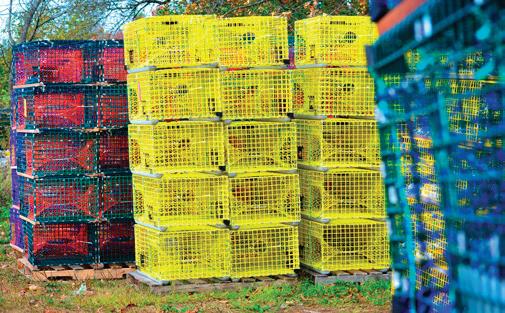


26 The Working Waterfront april 2024
JB Paint Company INDUSTRIAL MARINE COATINGS & SUPPLY Epoxy & Urethane Coatings Blast Media & Supplies, Sprayers, Sprayer Repair/Supplies....and more.... 2225 Odlin Road, Hermon ME 04401 207-942-2003 art of the waterfront GET H A ULIN’ Jonesboro, ME (207) 434-5791 Portland, ME (800) 244-8727 Thomaston, ME (800) 426-4526 West Bath, ME (855) 848-6027 BROOKSTRAPMILL.COM Enter to win a $100 gift certificate by visiting our website or “Like” us on Facebook. BROOKS TRAP MILL & MARINE SUPPLIES A large selection of traps and trap kits Stop by for all your fishing and commercial boating needs CHASLE21.PLT 2/10/2021 2:43:50 PM PORTLAND 207-772-6383 ELLSWORTH 207-667-9390 NEW LOCATION IN PORTLAND: 84 COVE STREET MARINE SAFETY CONSULTING LIFE RAFT INSPECTIONS Life Raft Sales and Inspections Inflatable Boats • Charts Books • Navigational Tools Linkel Construction, Inc. Locally owned and operated; in business for over twenty-five years. • Specializing in slope stabilization and seawalls. • Department of Environmental Protection (DEP) certified. • Experienced, insured and bondable. Free site evaluation and estimate. • One of the most important investments you will make to your shorefront property. • We have the skills and equipment to handle your largest, most challenging project. For more information: www.linkelconstruction.com 207.725.1438
“The J. O. Brown Boatyard, North Haven” (2012) by Seaver Leslie; transparent watercolor, 11-inches by 14 inches.
Foy and his crew were, even as they concentrated on their tasks.
“There was a good word for everyone who stopped by,” he recalls.
Leslie waxes lyric about the family-owned business that has built lobster boats, launches, and sailing vessels for going on 140 years.
“The texture and spirit evident there; the materials; the design of the vessels; the tools that have been handled by the boatbuilders’ forebears and passed, with their knowledge, to the next generation—all of this counts in making a well-functioning and beautiful wooden boat by hand.”
These crafts, the painter further notes, are “archetypal designs that have existed on Maine waters for centuries.” That fact puts the boats and their builders “in harmony with the past and the present, land and sea.”
The Boston-born Leslie first visited North Haven when he was 13 and crewing on the schooner Alida. He remembers mooring in the Thorofare and taking on fuel and provisions from Brown’s Boatyard. Later, as a young man, he returned to the island to see his friend and fellow painter Eric Hopkins.
He has also had occasion to visit architect Toshiko Mori and her husband, sculptor-architect James Carpenter (Hopkins’s mother, June, encouraged the couple to buy the old Cushing Thomas farm in 1984).
Leslie’s CV includes teaching appointments and artist residencies at the Rhode Island School of Design (where he earned BFA and Master of Education degrees), Parsons, Wellesley, and the University of California, San Diego.
A classmate of famed glass artist Dale Chihuly at RISD, the two collaborated on “Ulysses Cylinders,” inspired by James Joyce’s novel. Leslie is also known for his allegorical paintings, which critic Edgar Allen Beem once described as “unqualified” indictments of “modern America for crimes against the earth and her people.”
Leslie also founded Americans for Customary Weight and Measure, an organization that called for an end to the metric system in the U.S. in the early 1990s.
“Good old Yankee common sense beat down the effort of these people trying to make a buck from simply changing over from one measurement system to another,” he told a Christian Science Monitor reporter at the time.
A longtime resident of Wiscasset—family ties go back more than a century— Leslie helped spearhead a campaign in 1995 to create the Morris Farm Trust, preserving one of the last working farms in the area. The trust promotes sustainable agriculture and stewardship through education and community involvement, while enhancing food security in the midcoast.

In light of the recent heroic efforts to save and restore the J. O. Brown Boatyard during and after the January storms, Leslie reflected on what the place means to North Haven islanders: “It’s the hub of the island—the absolute center of its traditional culture and daily life,” he writes. “It’s the omphalos stone—one of the last bastions of Maine’s great craftsmanship tradition.”
Leslie also considers the boatyard to be the bulwark against what he calls “the oncoming tide of senseless,
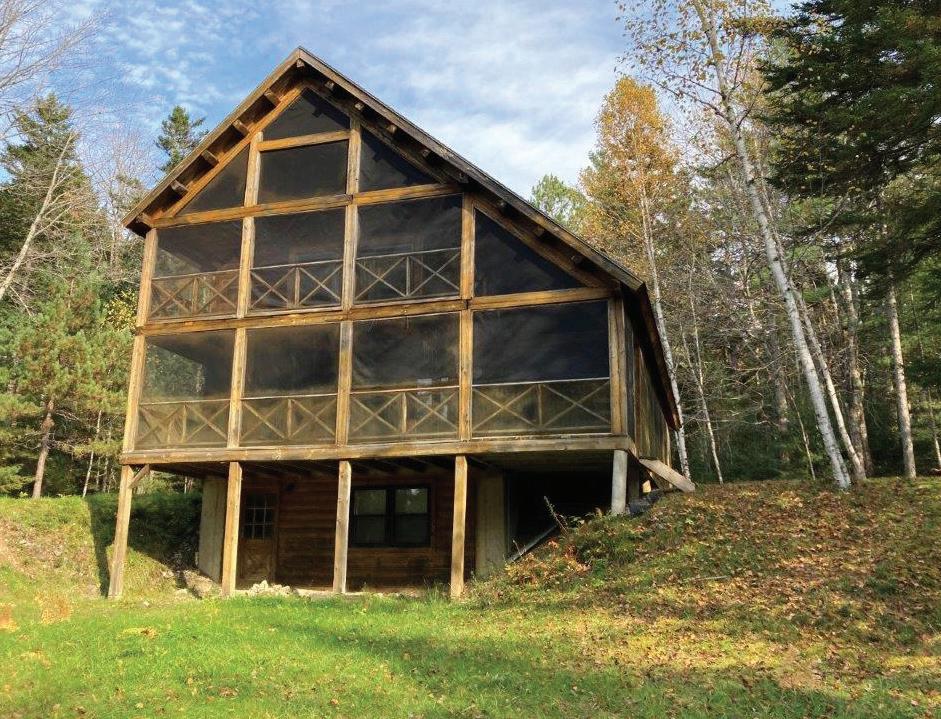


short-sighted ‘progress’” and “an important beacon for young people, showing how beautiful, useful things can be crafted in the old way, with care and purpose.” His brilliant watercolor is a testament to his passion for this special place.
Carl Little’s latest book, co-authored by his brother David, is The Art of Penobscot Bay (Islandport Press).
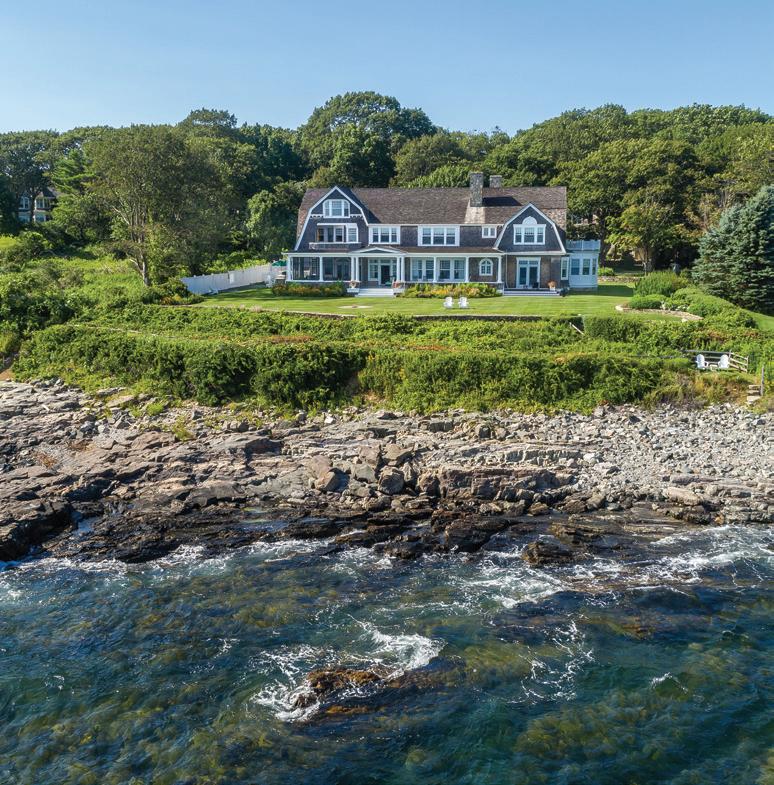
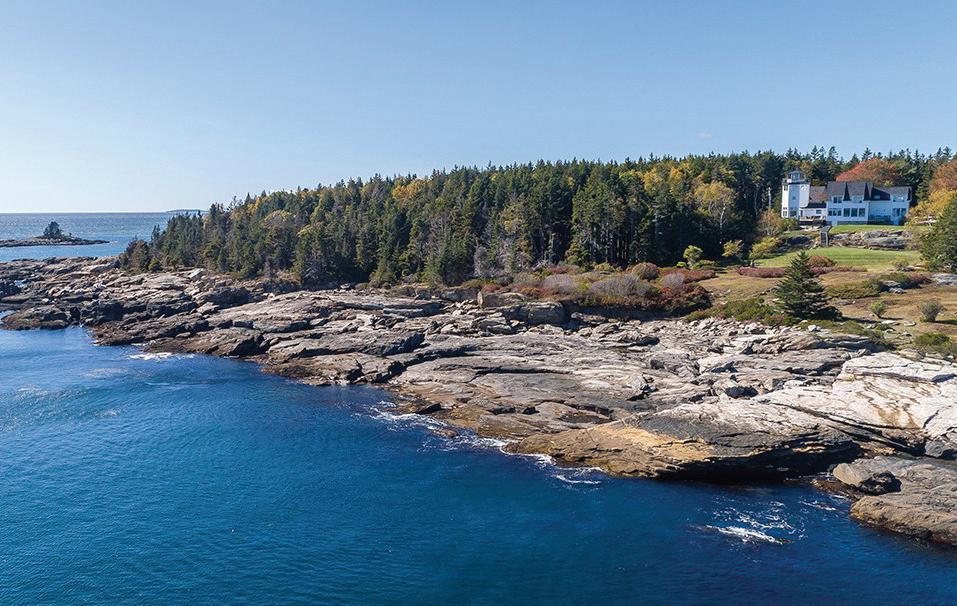

Portland:

27 www.workingwaterfront.com april 2024
Maine Offices: Camden: 23 Main Street | 207-236-3543 Northeast Harbor: 125 Main Street | 207-276-3840
36 Danforth Street |
Our teams specialize in luxury waterfront, village and island properties, as well as distinctive farms across Maine. We travel the back roads, we navigate the waters, and we know luxury real estate in Maine. Contact our team today. TACY RIDLON (207) 266-7551 TACYRIDLON@MASIELLO.COM With 955 feet on the Narraguagus River to include the river bend, this log cabin sits on 20 pristine acres with mature tree growth and lovely views of rushing white water. Off grid, the electricity is supplied by solar panels with a back-up generator to power all when need be. Set of 16 new batteries in September, everything is running smoothly with lights and appliances. The house has an interesting custom, granite fireplace with recessed mortar to accentuate the shapes of granite. Warm wood interior with all the conveniences, 2 full baths, 2 full bedrooms on the second floor with finished office space on the lowest level with views of the river. Large, screened porch on first floor and large screened porch off the master bedroom on the second floor to hear the river moving day and night. An enchanting property. $450,000.
207-774-8518
Seaver Leslie PHOTO: MARTIN ANDREWS
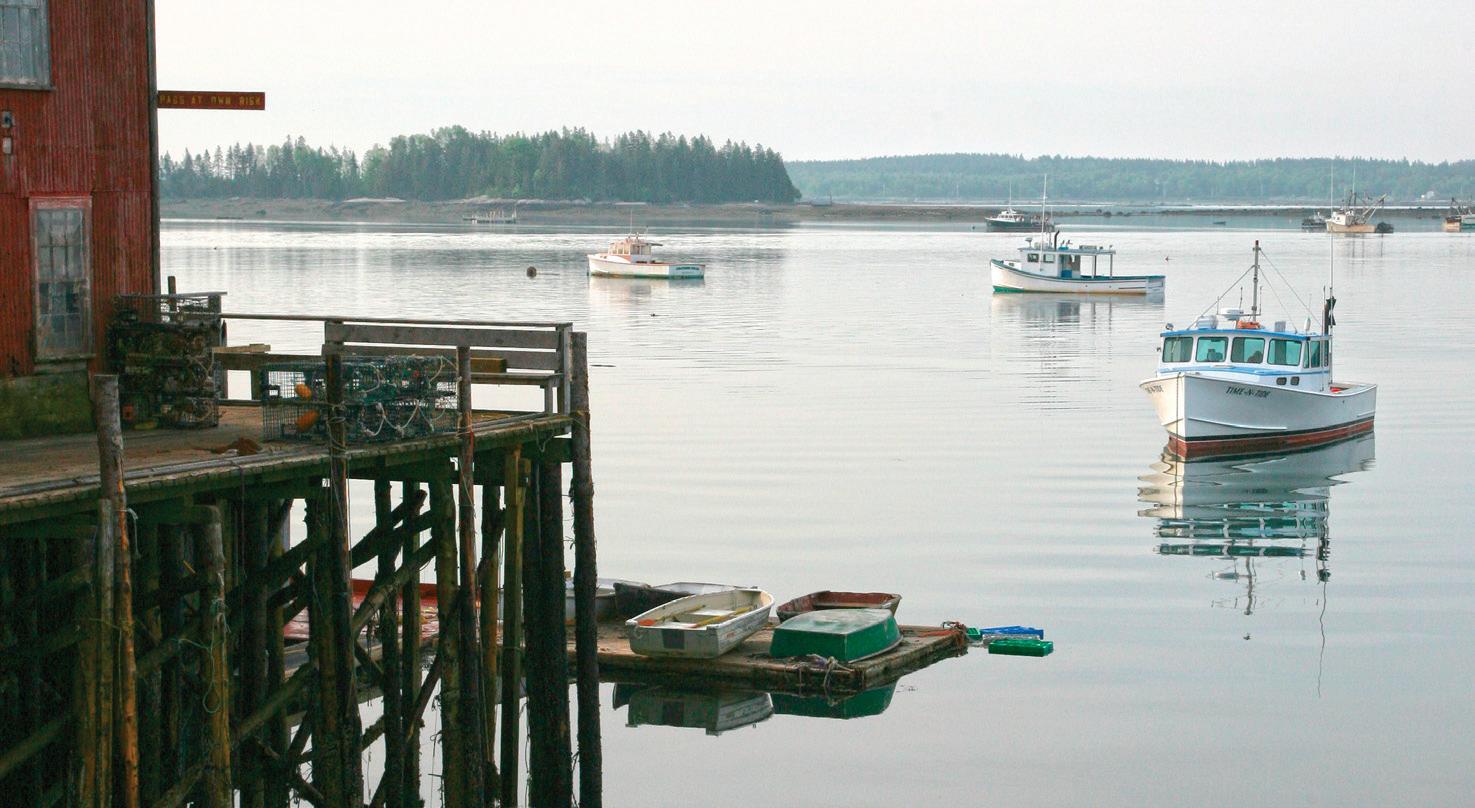

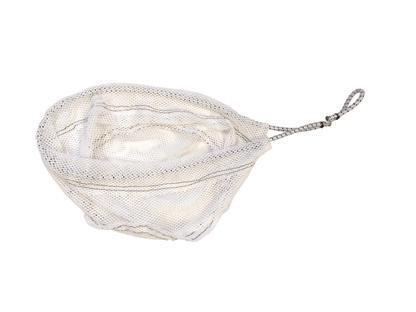









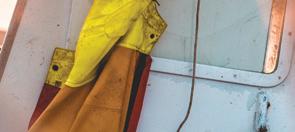









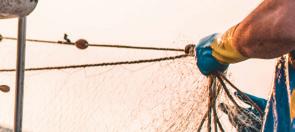










“Having
has been a dream of mine. Island Institute was with me every
and gave me the
and resources I needed to make it happen.”
28 The Working Waterfront april 2024 1 Online at giving.islandinstitute.org 2 Call the Island Institute office at (207) 747-1180 3 Mail your gift to: Island Institute, PO Box 648, Rockland, ME 04841 Enduring Impact Krista Tripp has been lobstering her whole life. In 2018, by enrolling in Island Institute’s Aquaculture Business Development program, Krista was able to access hands-on training experience that helped her diversify into farming oysters. Today, Krista’s Aphrodite Oysters, grown in the Weskeag River in South Thomaston, are found on the menus of oyster bars all around the state of Maine! This year, Island Institute was able to help Krista secure funding for a solar array, making her business more sustainable and affordable. Investing in people and livelihoods on the coast of Maine is one example of how your gift can make a difference! Please consider supporting Island Institute’s work in your community with a year-end gift today.
an oyster business
clean
step of
way
TRIPP Nobody finances commercial fishing like Farm Credit East. Like agriculture, the fishing industry has its own unique credit needs. And we’re proud to serve them both. No other lender offers more expertise, specialized financial products, or dedicated services to achieve your goals. farmcrediteast.com | 800.831.4230 Financing For: Boats & Trucks Real Estate Permits Bait Storage Facilities Wharves Equipment Haul Out & Repair Operating Lines OUR BUSINESS IS TO LEND YOU MONEY. OUR MISSION IS TO GROW YOUR SUCCESS. 11530_FISHING_Made in Ag_Our Business_4.9x7.35.indd 1 10/8/19 1:03 PM Elver Fishing Supplies Why source and supply out there all alone, help is always waiting ashore at Hamilton Marine. We are proud to serve fishermen and boaters alike with strong customer relationships and a vast inventory at our stores and warehouses. Our crew is always here to provide you with what you need to help outfit your boat. KITTERY • PORTLAND • ROCKLAND SEARSPORT • SW HARBOR • JONESPORT Description Order# SELL A Wonder Grip Gloves 762677 12.99 B Elver Strainer 750131 25.99 C Telescoping Elver Net 118503 90.99 D 5 Gallon Bucket E Litezall Combo Pack has it Fits Five Gallon Bucket A B C D E Saturday April 6th to Sunday April 14th 2024! Shop our lowest prices of the year! hamiltonmarine.com 800-639-2715
powered by
energy
the
tools, knowledge
—KRISTA





















































 Olivia Britton
Olivia Britton





































































